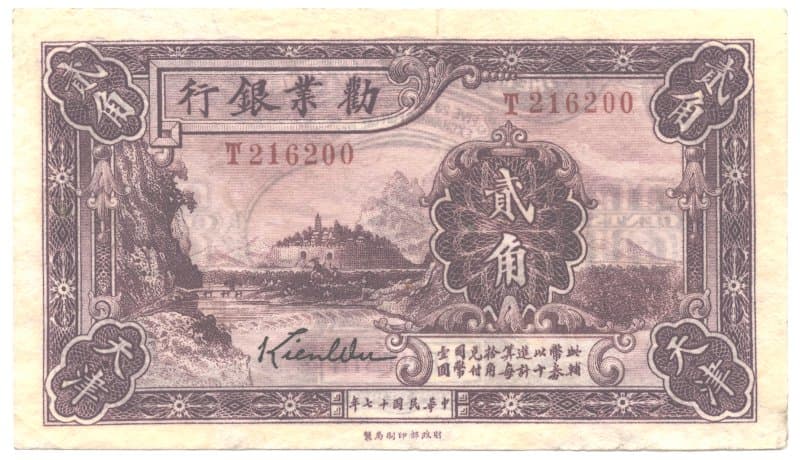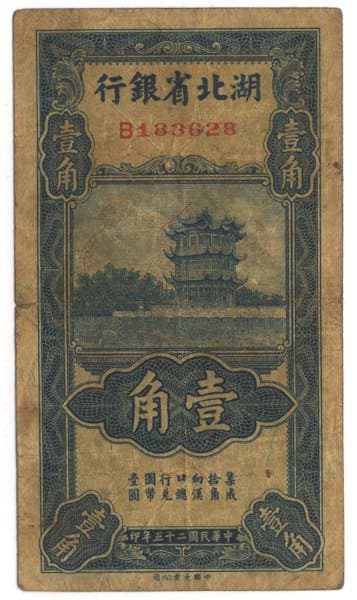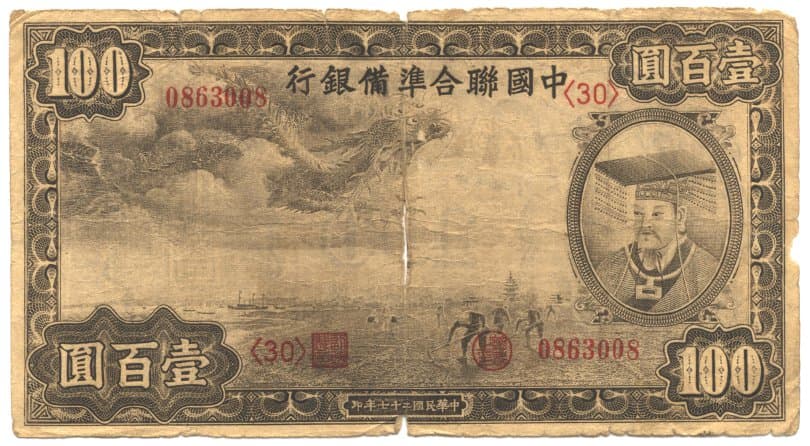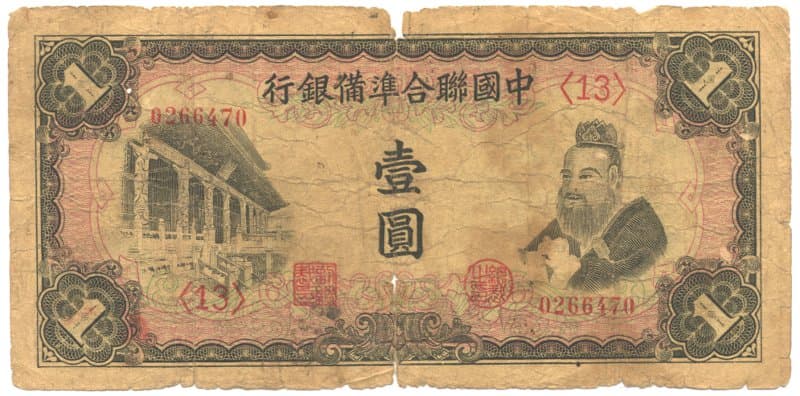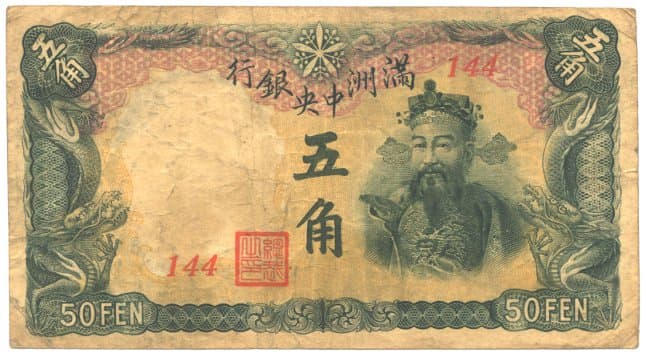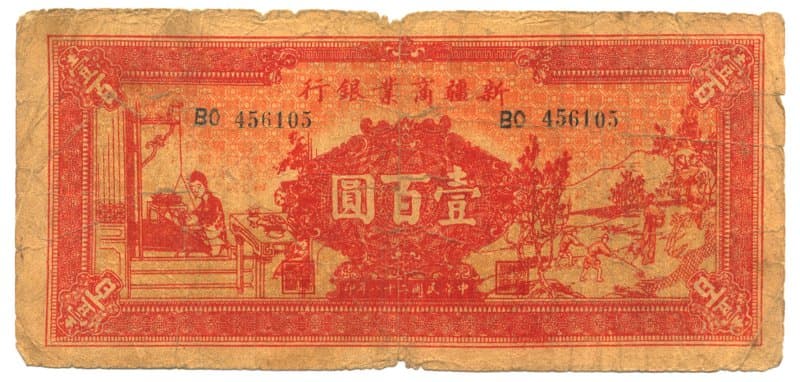
Chinese Paper Money

Introduction to Chinese Paper Currency
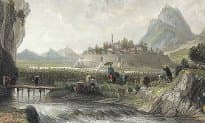 China is not only
credited with having invented paper but it is also generally
recognized to have been the first country in the world to use
paper money.
China is not only
credited with having invented paper but it is also generally
recognized to have been the first country in the world to use
paper money. The inspiration for China's paper money actually came from the "white deerskin" money (bai lu pi bi 白鹿皮币) issued under the reign of Emperor Wu (141 BC - 87 BC) of the Han Dynasty, and the "flying money" (fei qian飞 钱) of the Tang Dynasty (618-907 AD).
True paper money became a major form of currency during the Northern Song Dynasty (960-1127) with the issuance of the Jiao Zi (交子) and Qian Yin (钱引), and paper currency then continued under the Southern Song Dynasty (1127-1279) which issued the Hui Zi (会 子) and Guan Zi (关子).
The Jin Dynasty (1115-1234) issued paper money known as Jiao Chao (交钞) and Bao Quan (宝券), and the Yuan Dynasty (1271-1368) and Ming Dynasty (1368-1644) continued the issuing of paper money with the Bao Chao (宝钞).
Due to certain drawbacks associated with paper money, the Qing Dynasty (1644-1911) relied on coins for a long time with the exception of a brief period (1651-1661) during the Shun Zhi reign of Emperor Shi Zu. However, the situation changed in 1853 during the Xian Feng reign of Emperor Wen Zong when large military expenditures were required to suppress the Taiping Rebellion.
Two types of notes were issued. The Hu Bu Guan Piao ("Official Note of the Ministry of Interior and Finance" 户部官票) was issued in a denomination based on a tael of silver. In addition, the Da Qing Bao Chao ("Treasure Note of the Great Qing"大清宝钞) was issued with the denomination based on bronze coins.
A frequently used term for the Guan Piao (官票) and Bao Chao (宝钞) notes of the Qing Dynasty was chao piao (钞票). Chao piao has become a commonly used word for "paper money" or "bank note" in general.
During the late Qing Dynasty, the government as well as private banks issued various paper notes denominated in silver dollars, cash coins and tong yuan (machine-made copper coins 铜元). This was the beginning of the issuance of modern currency in China which then expanded greatly following the 1911 Revolution and during the Republican Period.
A number of the more interesting bank notes from this period are displayed and discussed in the sections below.
But, Chinese paper money is more than just a convenient a form of currency.
Pictures, called vignettes, were originally added to the design of paper money as a measure against counterfeiting.
 The vignettes are uniquely associated
with Chinese history, economics, politics, and culture.
Paper money provides a canvas upon which images of ancient
Chinese historical sites are displayed and preserved.
Some vignettes show world-famous structures such as the Great Wall of China, the Summer Palace and the Confucian
Temple at Qufu. Other vignettes display images of
ancient walled cities, temples, pagodas, pavilions,
towers, memorial arches,
bridges, etc. Some banknotes record scenes of the
introduction of new technology such as airplanes and trains
while other banknotes document famous
historical figures and the traditional daily life
of the Chinese people.
The vignettes are uniquely associated
with Chinese history, economics, politics, and culture.
Paper money provides a canvas upon which images of ancient
Chinese historical sites are displayed and preserved.
Some vignettes show world-famous structures such as the Great Wall of China, the Summer Palace and the Confucian
Temple at Qufu. Other vignettes display images of
ancient walled cities, temples, pagodas, pavilions,
towers, memorial arches,
bridges, etc. Some banknotes record scenes of the
introduction of new technology such as airplanes and trains
while other banknotes document famous
historical figures and the traditional daily life
of the Chinese people.There are even examples of Chinese paper money that retain the image of historical sites which no longer exist due to natural disasters, wars or acts of revolution and rebellion.
Unfortunately, the vast majority of standard catalogs and reference books on Chinese paper money seem to ignore these vignettes. At best, these books may mention that there is an illustration of a "temple" or "pagoda" but do not provide any information as to what the historical site is or why it may have been important enough to be included in the design of the currency.
This article will attempt to address this oversight by giving additional background information on selected banknotes so as to provide a better understanding of Chinese history and culture as conveyed through the images on its paper money.
This is a banknote issued in 1928 by "The Industrial Development Bank of China" (quan ye yin hang 劝业银行) with a denomination of Two Jiao (erjiao 贰角 "twenty cents").
The note was printed by the "Bureau of Engraving and Printing, Peiping, China" (cai zheng bu yin shua ju 财政部印刷局).
The vignette shows the ancient walled city of Ningpo (宁波) in the distance with cotton fields in the foreground.
During the Ming and Qing Dynasties, the textile industry flourished in Ningpo which is a port city in Zhejiang Province on the east coast of China.
Ningpo is surrounded on three sides by mountains with a fertile plain in the middle which makes it ideal for growing cotton.
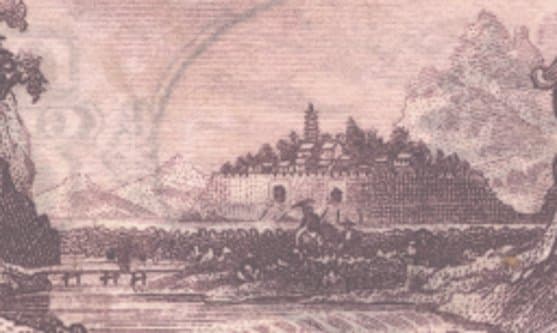

What is most interesting about this banknote is that the vignette (enlarged detail above) was based on a painting (detail above) by a 19th century English artist.
The illustration "Cotton Plantations in Ning-po" by Thomas Allom (1804-1872) (Chinese name: 托玛斯�阿罗姆) was published in China Illustrated in 1845.
The Ningpo city wall, seen in the illustration, was made of granite and was more than 5 miles in circumference. The wall had five gates and also two water gates. The Pengshan Pagoda (彭山塔), built in 1522-1566 during the Ming Dynasty, was made of brick and extended high above the city.
Thomas Allom traveled widely in many parts of the world and is famous for his illustrations of China. However, there is no credible evidence that he ever even visited China. The idealized scenes of old China he depicted in his illustrations are generally believed to have been based on the works of other artists.
Xian
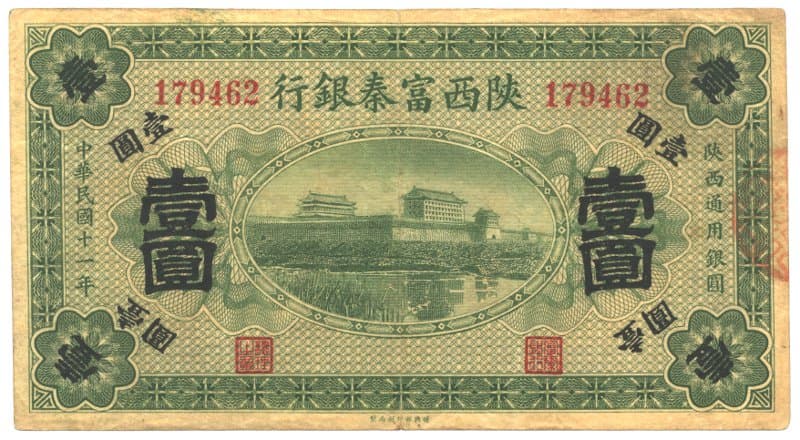
This is a One Yuan ("one dollar" yi yuan 壹 圆) banknote issued in the 11th year (1922) of the Republic of China by the Fu Ching Bank of Shensi (shanxi fu qin yinhang 陕西富秦银行). The note was printed by the Bureau of Engraving and Printing in Peking (cai zheng bu yin shua ju 财政部印刷局).
The vignette shows the city wall of the ancient city of Xian (西安) which is the capital of Shaanxi Province (陕西省).
Xian, formerly known as Chang'an (长安), has a history that extends back 3,100 years and served as the capital city for the following dynasties:
Zhou (1046 BC-256 BC)
Qin (221 BC-207 BC)
Han (206 BC-9 AD and 190-195)
Sui (581-618)
Tang (618-904)
Construction of the first Chang'an city wall began in 194 BC. It measured 25.7 km (16 miles) in length.
The city wall shown here was built during the reign of Zhu Yuanzhang (Emperor Taizu, Hongwu Emperor), the first emperor of the Ming Dynasty (1368-1644), who greatly enlarged the existing Tang Dynasty wall. The city wall stands 12 meters (40 feet) high and has a total length of 13.7 kms (8.5 miles). The wall is 15-18 meters (50-60 feet) in width at the base tapering to 12-14 meters (40-46 feet) at the top.
There are a total of 98 ramparts, each with a sentry building, extending out from the wall and spaced 120 meters apart. There are four main gates.
As can be seen, a wide and deep moat surrounds the perimeter of the wall. In the past, there was a drawbridge to allow access to the city.
The city wall of Xian is the most complete city wall still existing in China.
This is a One Jiao (yi jiao 一角 "ten
cents") banknote issued in the 25th year of
the Republic of China (1936) by the "Hupeh Provincial
Bank" (hu bei sheng
yin hang 湖北省银行).
The vignette shows the Yellow Crane Tower (huang he lou 黄鹤楼) located near the Yangzi River (chang jiang 长江) on the top of "Snake Hill" (she shan 蛇山) in Wuchang which is a district of Wuhan.
The name "Yellow Crane" derives from an ancient legend that an immortal mounted a yellow crane at this site and then flew away.
The Yellow Crane Tower was originally built as a military lookout post during the Three Kingdoms period (220-280). By the time of the Tang Dynasty (618-907), it had already become a famous sightseeing spot.
The tower was immortalized in the famous poem "Yellow Crane Tower" by the Tang Dynasty poet Cui Hao (崔颢) who lived during the years 704-754.
The vignette shows the Yellow Crane Tower (huang he lou 黄鹤楼) located near the Yangzi River (chang jiang 长江) on the top of "Snake Hill" (she shan 蛇山) in Wuchang which is a district of Wuhan.
The name "Yellow Crane" derives from an ancient legend that an immortal mounted a yellow crane at this site and then flew away.
The Yellow Crane Tower was originally built as a military lookout post during the Three Kingdoms period (220-280). By the time of the Tang Dynasty (618-907), it had already become a famous sightseeing spot.
The tower was immortalized in the famous poem "Yellow Crane Tower" by the Tang Dynasty poet Cui Hao (崔颢) who lived during the years 704-754.
黄鹤楼
昔人已乘黄鹤去, 此地空余黄鹤楼.
黄鹤一去不复返, 白云千载空悠悠.
晴川历历汉阳树, 芳草萋萋鹦鹉洲.
日暮乡关何处是? 烟波江上使人愁.
Long ago a man rode off on a yellow crane, all that remains here is Yellow Crane Tower.
Once the yellow crane left it never returned, for one thousand years the clouds wandered without care.
The clear river reflects each Hanyang tree, fragrant grasses lushly grow on Parrot Island.
At sunset, which direction lies my hometown? The mist covered river causes one to feel distressed.
昔人已乘黄鹤去, 此地空余黄鹤楼.
黄鹤一去不复返, 白云千载空悠悠.
晴川历历汉阳树, 芳草萋萋鹦鹉洲.
日暮乡关何处是? 烟波江上使人愁.
Long ago a man rode off on a yellow crane, all that remains here is Yellow Crane Tower.
Once the yellow crane left it never returned, for one thousand years the clouds wandered without care.
The clear river reflects each Hanyang tree, fragrant grasses lushly grow on Parrot Island.
At sunset, which direction lies my hometown? The mist covered river causes one to feel distressed.
The Yellow Crane Tower was actually rebuilt a number of times during the "one thousand years" mentioned in the poem. During the Ming and Qing Dynasties alone it was restored seven times.
In 1884 it was destroyed in a fire and was not rebuilt again until 1985. The reconstruction was based on the last surviving photograph of the tower which dated from the 7th year (1868) of the Tong Zhi reign of Emperor Mu Zong of the Qing Dynasty (1644-1911). The present tower is an authentic reproduction of the one that existed during the Qing Dynasty.
The tower has five stories reaching a height of 51 meters, has yellow glazed tiles, and is supported by 72 large pillars.
Qingchuan Pavilion

This banknote was issued in the 3rd year (1914) of the Republic of China by the "Hupeh Provincial Bank" (hu bei guan yin ju 湖北官钱局). The denomination is "One Hundred Copper Coins" (yi bai mei tong yuan 一百枚铜元) and was printed by the Bureau of Engraving and Printing in Peking (Beijing) (cai zheng bu yin shua bu 财政部印刷局).
The vignette on the right is the Yellow Crane Tower (huang he lou 黄鹤楼) which is discussed in detail in the section above.
The image on the left is the Qingchuan Pavilion (qingchuan ge 晴川阁), also known as the Qingchuan Tower.
The Qingchuan Pavilion is located on "Tortoise Hill" (gui shan 龟山) on the northern bank of the Yangtze River (changjiang 长江) and faces the Yellow Crane Tower located on "Snake Hill" (she shan 蛇山) on the opposite side.
The pavilion was originally built during the Jia Jing reign (1522-1567) of Emperor Shi Zong of the Ming Dynasty. It was constructed to commemorate "Yu the Great" (da yu 大禹) who was the legendary founder of the Xia Dynasty (21st century - 16th century BC) and is renowned for his dedication and perseverance in controlling flooding by China's rivers.
Yu was assisted in his work by a black tortoise and a yellow dragon so it was appropriate that a pavilion honoring him was built on "Tortoise Hill" next to the Yangtze River.
The name for the pavilion, Qingchuan, was taken from a line in the poem "Yellow Crane Tower" by the Tang Dynasty poet Cui Hao (崔颢) which was quoted in the section above:
晴川历历汉阳树, 芳草萋萋鹦鹉洲.
Qingchuan li li han yang shu, fang cao qi qi ying wu zhou.
The clear river reflects each Hanyang tree, fragrant grasses lushly grow on Parrot Island.
Qingchuan li li han yang shu, fang cao qi qi ying wu zhou.
The clear river reflects each Hanyang tree, fragrant grasses lushly grow on Parrot Island.
Mao Zedong (毛泽东) in 1927 also wrote a poem entitled the "Yellow Crane Tower" in which one line alludes to "Tortoise Hill", "Snake Hill" and the epic flood control work of "Yu the Great":
龟蛇锁大江
gui she suo da jiang
The Tortoise and the Snake hold the great river locked.
The Qingchuan Pavilion was renovated several times during the Shun Zhi, Yong Zheng, Tong Zhi and Guang Xu reigns of the Qing (Ch'ing) Dynasty (1644-1911) but was later destroyed in a fire.
The present Qingchuan Pavilion was renovated in 1983 based on an old photograph of the structure dating from the late Qing Dynasty.
gui she suo da jiang
The Tortoise and the Snake hold the great river locked.
The Qingchuan Pavilion was renovated several times during the Shun Zhi, Yong Zheng, Tong Zhi and Guang Xu reigns of the Qing (Ch'ing) Dynasty (1644-1911) but was later destroyed in a fire.
The present Qingchuan Pavilion was renovated in 1983 based on an old photograph of the structure dating from the late Qing Dynasty.
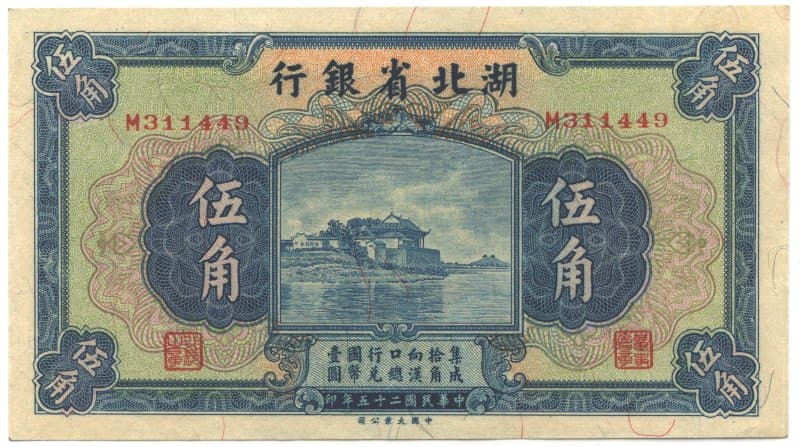
This banknote was issued in 1936 by the Hupeh Provincial Bank (hu bei sheng yin hang 湖北省银行) with a denomination of Five Jiao (wu jiao 五角 "fifty cents"). It was printed by the China Ta Yeh (Dah Yip) Company (zhong guo da ye gong si 中国大业工司).
The vignette in the center of the note is the Guqin Tai (古琴台) which is variously translated as the Guqin Terrace, Heptachord Terrace and Lute Platform.
Guqin Tai is located near the city of Wuhan in Hubei Province. It is west of Tortoise Hill (gui shan 龟山) on the bank of Moon Lake (yue hu 月湖).
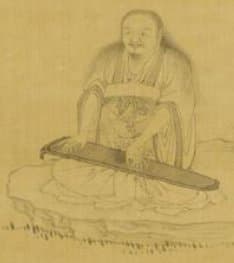 The guqin (古琴)
is a very ancient Chinese musical instrument
that, according to legend, has been closely associated
with the scholarly class including Confucius for 5,000 years.
The guqin (古琴)
is a very ancient Chinese musical instrument
that, according to legend, has been closely associated
with the scholarly class including Confucius for 5,000 years.The guqin is a plucked seven-string instrument as can be seen in the painting at the left.
The image is a detail from an ink on silk painting by the 13th century Chinese painter Qian Xuan (钱选) which is in the collection of the Smithsonian Institution.
Guqin Tai was built to honor Bo Ya (伯牙) who was an accomplished guqin player and an official of the State of Jin during the Spring and Autumn Period (770 BC - 476 BC).
According to a passage from the Liezi (列子), an ancient Daoist text, Bo Ya was returning home by boat one day from an official visit to the State of Chu. A woodcutter by the name of Zhong Ziqi (钟子期) happened to hear Bo Ya playing two pieces of music on his guqin. The two pieces were "High Mountain" (高山) and "Flowing Water" (流水). Bo Ya was amazed by the woodcutter's deep understanding of the music and the two quickly became close friends.
Bo Ya needed to continue his journey home but before leaving his new friend he promised to return in one year.
As promised, Bo Ya returned the next year only to discover that his friend had died. Bo Ya was deeply saddened by the news and immediately went to burn incense at the woodcutter's grave. He also played "High Mountain" and "Flowing Water" on his guqin in honor of his friend. But the loss of his bosom friend was so great, and the music was so moving, that upon finishing the two pieces Bo Ya immediately broke his guqin and vowed to never play again.
The story of Bo Ya and Zhong Ziqi is considered by the Chinese to epitomize the Chinese notion of zhi yin (知音) which literally translates as "to know music" but which is used to mean "one who truly knows me".
Guqin Tai was built on the site where it is believed Bo Ya played the guqin for his friend. The original structure was built during the Northern Song Dyansty (960-1127) but later suffered damage. It was restored during the Jia Qing reign of Emperor Ren Zong (1796-1820) of the Qing (Ch'ing) Dynasty.
The two musical pieces, "High Mountain" and "Flowing Water", played by Bo Ya remain as standards of the guqin repertoire. Guan Pinghu (管平湖), one of the most famous guqin players of the 20th century, has a recording of "Flowing Water".
Fang He Pavilion
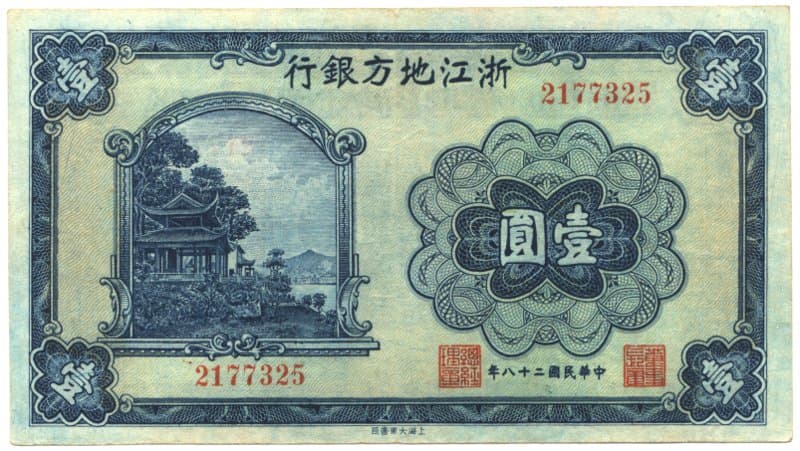
This banknote was
issued in 1941 by The Chekiang Provincial Bank (zhe jiang di fang yin
hang 浙江地方银行) with a denomination of One Yuan
(yi yuan 壹
圆 "one dollar"). The note was
printed by Ta Tung (Dah Tung) Printing in Shanghai (shanghai da dong shu ju
上海大东书局).
The vignette shows the Fang He Pavilion (fang he ting 放鹤亭) at the famous West Lake (xi hu 西湖) of Hangzhou (杭州) in Zhejiang Province.
Fang He Pavilion is located on Solitary Hill (gu shan 孤山), which is the only natural island at West Lake, and reaches a height of only 38 meters. Its natural beauty is best described by the famous Tang Dynasty poet Bai Juyi (白居易 772-846) as:
The vignette shows the Fang He Pavilion (fang he ting 放鹤亭) at the famous West Lake (xi hu 西湖) of Hangzhou (杭州) in Zhejiang Province.
Fang He Pavilion is located on Solitary Hill (gu shan 孤山), which is the only natural island at West Lake, and reaches a height of only 38 meters. Its natural beauty is best described by the famous Tang Dynasty poet Bai Juyi (白居易 772-846) as:
蓬莱宫在水中央
peng lai gong zai shui zhong yang
The fairyland in the midst of the lake
peng lai gong zai shui zhong yang
The fairyland in the midst of the lake
Fang He Pavilion
was originally built during the Yuan Dynasty
(1271-1368) to commemorate the life of Lin Hejing
(林和靖) who is also known as Lin Bu (林逋).
Lin Hejing was a poet and artist who lived during
the years 967-1028 of the Northern Song Dynasty.
Lin Hejing lived an unusual life, however. Although talented, he never sought fame and did not participate in the imperial examinations to become a government official. He never married, either.
Instead, he chose to live the life of a hermit on Solitary Hill.
Lin Hejing had two loves in his life. He loved plum blossoms and cranes. He spent his time planting more than 300 plum trees and raising cranes on Solitary Hill.
The fang he in Fang He Pavilion means "to raise cranes".
He was so dedicated to these endeavors that people said he had taken "the plum blossom as his wife and the cranes as his children" (mei qi he zi 梅妻鹤子).
Emperor Zhen Zong (998-1022) and Emperor Ren Zong (1023-1063) of the Song Dynasty were so impressed with his accomplishments that they considered him to be an official who had not been appointed and bestowed upon him the title "(Lin) Hejing scholar in retirement" (he jing chu shi 和 靖处士).
The original Fang He Pavilion built during the Yuan Dynasty was expanded during the Ming and Qing dynasties. The current pavilion was rebuilt in 1915.
In the pavilion stands a stone stele, 3 meters in height and 2.4 meters in width, upon which is inscribed a poem by Bao Zhao (鲍照) who lived during the years 414-466 in the state of Song during the Southern Dynasties. The poem is entitled "Rhapsody on Dancing Cranes" (wu he fu 舞鹤赋). The calligraphy used on the stele was ordered by Emperor Kang Xi (1662-1722) of the Qing Dynasty to be modeled on the style of Dong Qichang (董其昌 1555-1637), a very famous calligrapher of the Ming Dynasty.
Lin Hejing is buried on Solitary Hill and next to his tomb are buried some of the cranes he raised.
Lin Hejing lived an unusual life, however. Although talented, he never sought fame and did not participate in the imperial examinations to become a government official. He never married, either.
Instead, he chose to live the life of a hermit on Solitary Hill.
Lin Hejing had two loves in his life. He loved plum blossoms and cranes. He spent his time planting more than 300 plum trees and raising cranes on Solitary Hill.
The fang he in Fang He Pavilion means "to raise cranes".
He was so dedicated to these endeavors that people said he had taken "the plum blossom as his wife and the cranes as his children" (mei qi he zi 梅妻鹤子).
Emperor Zhen Zong (998-1022) and Emperor Ren Zong (1023-1063) of the Song Dynasty were so impressed with his accomplishments that they considered him to be an official who had not been appointed and bestowed upon him the title "(Lin) Hejing scholar in retirement" (he jing chu shi 和 靖处士).
The original Fang He Pavilion built during the Yuan Dynasty was expanded during the Ming and Qing dynasties. The current pavilion was rebuilt in 1915.
In the pavilion stands a stone stele, 3 meters in height and 2.4 meters in width, upon which is inscribed a poem by Bao Zhao (鲍照) who lived during the years 414-466 in the state of Song during the Southern Dynasties. The poem is entitled "Rhapsody on Dancing Cranes" (wu he fu 舞鹤赋). The calligraphy used on the stele was ordered by Emperor Kang Xi (1662-1722) of the Qing Dynasty to be modeled on the style of Dong Qichang (董其昌 1555-1637), a very famous calligrapher of the Ming Dynasty.
Lin Hejing is buried on Solitary Hill and next to his tomb are buried some of the cranes he raised.
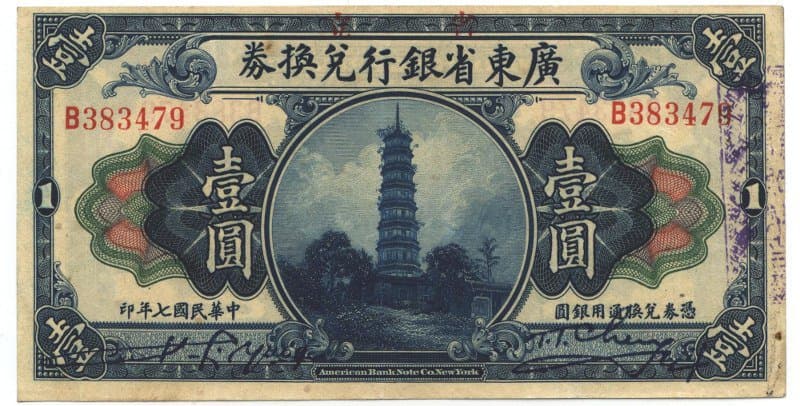
This is a One Yuan (壹圆 "one dollar") denomination banknote issued by "The Provincial Bank of Kwang Tung Province" (guangdong sheng yinhang 广东省银行) in the 7th year (1918) of the Republic of China. The note was printed by the American Bank Note Company of New York.
The Guangzhou Flowery Pagoda (hua ta 花塔), also known as the Pagoda of the Temple of the Six Banyan Trees (liu rong si ta 六榕寺塔), was built in the third year (537) of Da Tong reign of Emperor Wu Di of the Liang Dynasty (502-557) of the Southern Dynasties (420-589). The original name of the pagoda was the He Li Pagoda (舍利塔) of the Bao Zhuang Yan Temple (宝庄严寺).
The pagoda was destroyed by fire at the beginning of the Song Dynasty but then rebuilt in the year 1097.
During a visit, the famous Song Dynasty poet Su Dongpo (苏东坡), also known as Su Shi (苏轼), saw six ancient banyan trees in the courtyard and wrote the inscription "six banyan trees" (liu rong 六 榕). The temple has been known as the Temple of the Six Banyan Trees ever since.
The present pagoda was rebuilt during the Qing (Ch'ing) Dynasty (1644-1911) but still retains the characteristics of Song Dynasty architecture.
The pagoda is octagonal-sided and constructed of brick and wood. It is 57.6 meters in height. Nine stories are seen from the outside but the inside actually has 17 stories. Each story has an outside wood balcony. The tiles are vermilion in color.
At the very top of the pagoda is a 9.14 meter tall steeple. The steeple weighs 5 tons and the copper mainstay at the top, which was cast in the year 1358 of the Yuan Dynasty (1271-1368), has nine tiers of discs and is engraved with more than 1,000 images of the Buddha.
Shibaozhai
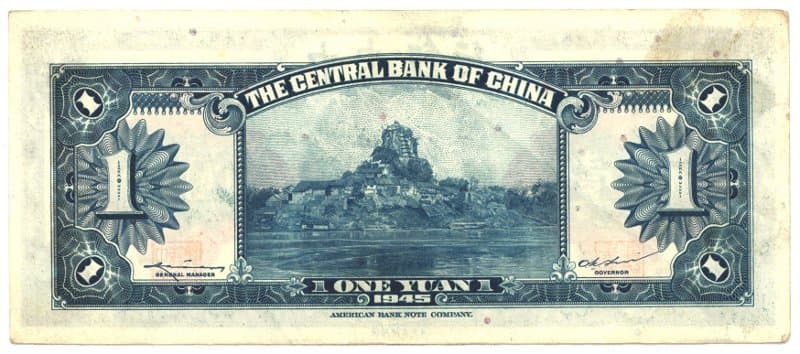
This is the reverse side of a One Yuan ("One Dollar") note issued in 1945 by The Central Bank of China (zhongyang yinhang 中央银行) and printed by the American Bank Note Company.
The vignette shows Shibaozhai (石宝寨) which is located on a steep 220 meter (722 foot) tall hill on the north bank of the Yangtze River (Changjiang 长江) in Zhong Prefecture (忠县) near Chongqing, Sichuan Province. The hill resembles a jade seal (yu xi 玉 玺) from a distance and is, therefore, known as "Jade Seal Mountain" (yu yin shan 玉印山).
Shibaozhai translates as "Stone Treasure Fortress" or "Precious Stone Fortress". A peasant uprising near the end of the Ming Dynasty (1368-1644) used the site as a "fortress" which is how it got its name.
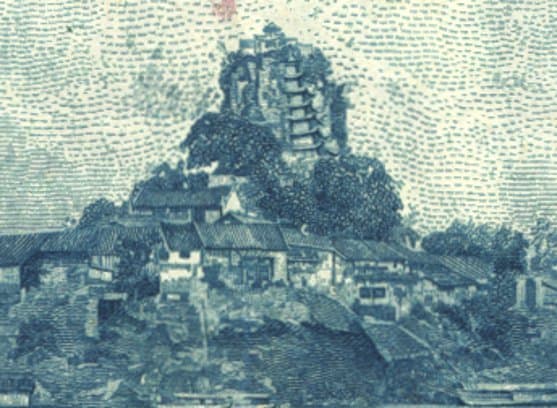 An enlarged section of the vignette is
shown at the left.
An enlarged section of the vignette is
shown at the left.At the very top of the hill can be seen the three-storied "Purple Rain Pavilion" (gan yu gong 绀雨宫), also known as the "Ganyu Palace" and "Ganyu Hall", which was built during the reign of Emperor Xianfeng (1851-1861) and dedicated to the Buddhist bodhisattva Manjusri.
Leading up to the temple is a wooden pavilion which actually utilizes the steep side of the rock precipice as one of its sides.
By entering the pavilion at the base, a person can then climb up and exit the top of the pavilion to reach the temple.
The temple was originally accessed only by climbing an iron chain attached to the side of the cliff. In 1819, during the reign of Emperor Jiaqing (1796-1820), the wood pavilion was built to make the climb more convenient.
The wood pavilion was originally nine stories tall and was referred to as "Nine Level Heaven" (jiu chong tian 九重天).
During renovation in 1956, three additional levels were added making a total of twelve stories with a total height of 56 meters (184 feet).
The pavilion is remarkable not only because it has three-sides made of wood and uses the cliff as its fourth side but also because no metal nails were used in its construction.
Each of the twelve stories is dedicated to a famous general of the Three Kingdoms Period, a famous poet or a local scholar.
In front of the temple at the top is the "Duck Well". It is so named because if one drops a live duck down the well it will quickly reappear swimming in the river below. In earlier times, it is said that the monks used a long bamboo pipe in this "well" to draw their drinking water.
In the main hall of the temple is a "spirit wall" made from bricks excavated from the Han Dynasty.
The temple includes a statue of Guan Yu (关 羽, 162-219) who is worshipped as the "God of War".
Other halls in the temple are dedicated to Zhang Fei (张飞, 167-221) and Yan Yan (严筵, 153-220) both of whom were generals of Shu Han during the Three Kingdoms Period. Another hall honors the female General Qin Liangyu (秦良玉, 1576-1648) who fought to preserve the Ming Dynasty against the Manchus who eventually established the Qing Dynasty (1644-1911).
The rear hall contains the "Rice Flowering Hole". According to legend, rice would flow up from this small well each day in an amount sufficient to feed the monks. This is the origin of the word "treasure" in the name "Stone Treasure Fortress". However, one day a greedy monk decided to enlarge the hole to obtain more rice. From that time on, rice never again appeared.
There is a mural inside the temple which illustrates the origin of the Jade Seal Mountain upon which Shibaozhai sits. According to Chinese mythology, the mountain is one of the "colored stones" Nu Wa (n�wa 女娲), the wife of Fu Xi (伏 羲), used to repair the heavens.
With the building of the Three Gorges Dam, a large retaining wall was built around Shibaozhi to protect it from the rising waters of the lake that has formed. Shibaozhi is now an island.
Dragon Pavilion
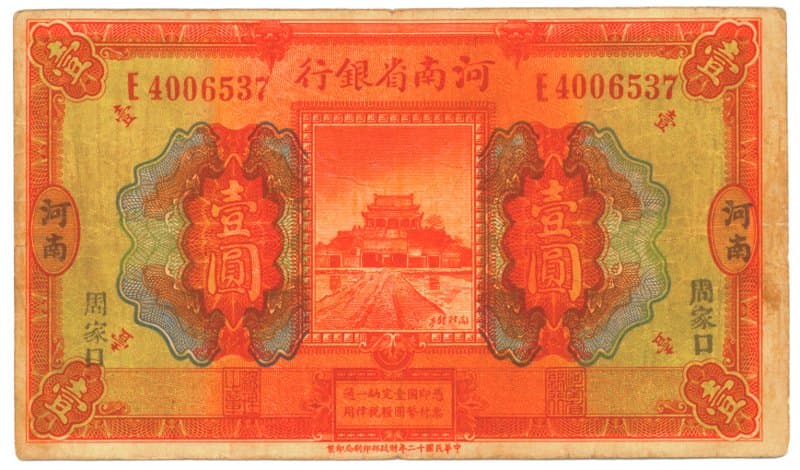
This very colorful banknote was issued by the Provincial Bank of Henan (Honan) (henan sheng yin hang 河南省银行) on July 15th 1923 which was during the 12th year of the Republic. The denomination is "One Yuan" ("one dollar") (yi yuan 一元) and the note was printed by the Bureau of Engraving and Printing (cai zheng bu yin shua bu 财政部印刷局).
The vignette in the center of the banknote is the image of the Dragon Pavilion (long ting 龙亭) located in the city of Kaifeng (开封) in Henan Province.
Kaifeng is one of the "Seven Ancient Capitals of China" and was the capital during the following periods:
State of Wei (魏)
beginning in 364 BC during the Warring States Period
(475 BC -221 BC)
Later Liang Dynasty (hou liang 后梁 907-923) during the Five Dynasties and Ten Kingdoms (907-960)
Later Liang Dynasty (hou liang 后梁 907-923) during the Five Dynasties and Ten Kingdoms (907-960)
Later Jin Dynasty (hou jin 后晋
936-946) during the Five Dynasties and Ten Kingdoms
Later Han Dynasty (hou han 后汉
947-950) during the Five Dynasties and Ten Kingdoms
Later Zhou Dynasty (hou zhou 后周 951-960) during the Five Dynasties and Ten Kingdoms
Northern Song Dynasty (bei song 北宋 960-1127)
Jin Dynasty (jin 金 1115-1234)
Later Zhou Dynasty (hou zhou 后周 951-960) during the Five Dynasties and Ten Kingdoms
Northern Song Dynasty (bei song 北宋 960-1127)
Jin Dynasty (jin 金 1115-1234)
Kaifeng is believed to have been the largest city in the world during the 11th century when it was an important commercial hub on a major river and connected to four major canals including the Grand Canal.
During the reign of Emperor Zhu Yuanzhang (Hongwu 1328-1398) of the Ming Dynasty, a mansion for Prince Zhou was built on top of a high mound in the city. However, a flood near the end of the Ming destroyed the mansion and only the dirt mound remained.
In 1692, Emperor Sheng Zu (Kangxi) of the Qing (Ch'ing) Dynasty had a "Longevity Pavilion" (wan shou ting 万寿亭) constructed on the site to serve as a repository for the memorial tablets dedicated to previous emperors.
The "Dragon Pavilion", illustrated in the vignette above, is a very large wooden hall built during the reign of Emperor Xuan Zong (Dao Guang 1821-1850).
The Dragon Pavilion was built on a 13 meter (43 foot) high blue brick foundation to protect it from floods. Leading up to this pavilion is a 72 step stone staircase and in the middle of the staircase are the carvings of nine dragons.
As mentioned, there is a 72 step climb up to the pavilion. Seventy-two has been considered a very auspicious number by the Chinese since very ancient times. The number "72" is the result of multiplying "nine" by "eight". Odd numbers are considered "heavenly" and even numbers are considered "earthly". "Nine" is the largest "yang" or "male" number and represents authority and longevity while "eight" is the largest "yin" or "female" number.

This is a Ten Yuan ("ten dollar" shi yuan 拾元) banknote issued in 1937 by the Shansi Provincial Bank (shanxi sheng yinhang 山西省银行) and printed by the North Western Engraving and Printing Factory (xibei yinshua chang 西北印刷厂).
The vignette is an image of the Drum Tower (gulou 鼓楼) in Taiyuan (太原) which is the capital of Shanxi Province (山西省).
Drum towers and bell towers were used in olden times to sound the time. Drums usually marked the evening hours, especially when the city gates closed for the night, while bells usually sounded the morning hours.
The Taiyuan Drum Tower was situated in the center of the old city and the neighboring area was the city's financial and business district.
According to local records, the Drum Tower was built at the beginning of the Ming Dynasty (1368-1644).
The records state that it was more than "10 丈" (about 33 meters) high, more than "100 步" (about 167 meters) long east-to-west, and more than "80 步" (about 133.6 meters) wide south-to-north. The wooden building on top extended to a height of "7 丈" (about 23 meters). The building had carved railings and painted pillars and beams.
Yan Xishan (阎锡山) was the military leader who seized power in Shanxi following the Xinhai Revolution in 1911. In 1932, he had large posters hung from the Drum Tower with the slogans "Build and Produce to Save the Nation" (zaochan jiuguo 造产救国) and "Provincial Government Reconstruction and Planning" (shengzheng jianshe jihua 省政建设计划).
If you look carefully at the vignette you will see the slogan "Build and Produce to Save the Nation" (造产救国) hanging just above another slogan "Keep in Mind and Do Not Forget" (yong zhi bu wang 用志不忘).
The Drum Tower was destroyed during warfare in 1949.
The reverse side of this banknote has a picture of the "Dragon Gate" which is discussed in detail below.
Six Harmonies Pagoda
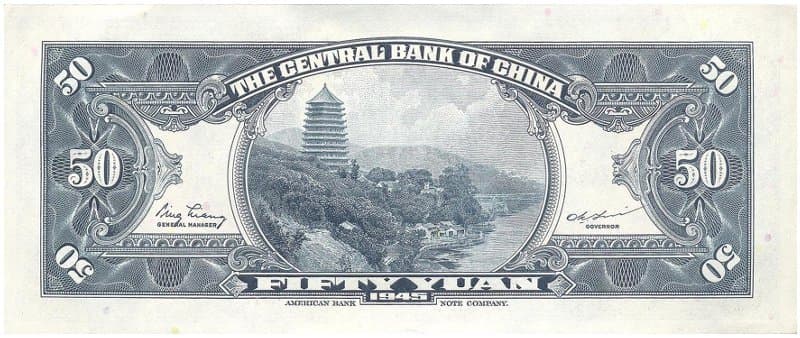
This is a Fifty Yuan ("Fifty Dollar" wu shi yuan 伍拾圆) banknote issued in 1945 by The Central Bank of China (zhongyang yinhang 中央银行) and printed by the American Bank Note Company.
The vignette is the Six Harmonies Pagoda ("Liuhe Pagoda" liuheta 六和塔) which is located on Yuelun Hill (月轮山) near the Qiantang River (钱塘江) in Hangzhou, Zhejiang Province.
The pagoda was originally built by King Qianchu (钱俶), the last king of the Wuyue Kingdom (吴越), in 970 AD during the Five Dynasties and Ten Kingdoms Period (五代十国). The pagoda was destroyed in 1121 in a war during the Northern Song. The brick exterior was rebuilt in 1156 and the restoration was completed in 1165 during the Southern Song.
The "six harmonies" refer to the "Six Harmonies of the Sangha" which are six rules stipulated by the Buddha to promote unity among his followers. These include corporal harmony (same work), verbal harmony (same silence), mental harmony (same tolerance), ethical harmony (same practice), ideological harmony (same understanding), and material harmony (same benefits).
Interestingly enough, the "Six Harmonies Pagoda" (liuheta 六和塔) is sometimes written incorrectly as the "Six Points Pagoda" (liuheta 六合塔). In Chinese, the pronunciation is the same but the meaning is very different. While the "six harmonies" is Buddhist, the "six points" is Daoist (Taoist). In Daoism, the "six points" can refer to Heaven, Earth and the four directions of north, south, east and west. The "six points" can also refer to the Daoist harmony of vital energy known as the "six qi" (气).
This pagoda was built not only to honor the Buddha but also to serve as a navigational aid and lighthouse.
This is due to the fact that the Qiantang River experiences the largest "tidal bore" in the world. A tidal bore is a large tidal wave which travels up a river against the current. The tidal bore on the Qiantang River can reach heights of 9 meters (30 feet) and travel 40 km per hour (25 mph).
Such a large tidal bore is very dangerous to ships as well as people on shore. Dating back to the time of its original construction, bright lamps were installed at the top of the pagoda at night to help guide ships on the river.
Additions have been made over the centuries since the first restoration of this wood and brick pagoda during the Southern Song. The seventh story and the spire were added during the Yuan Dynasty. The external eaves were added in 1900 during the Qing Dynasty (1644-1911).
The pagoda is octagonal in shape and has a height of 59.89 meters (196 ft). The interior has seven stories but the external eaves makes the structure appear to have thirteen stories.
Several interesting stories are associated with the Six Harmonies Pagoda.
Lu Zhishen (鲁智深), known variously as the "Flowery Monk", "Sagacious Lu" and the "Tattooed Monk", is one of the heroes of the "Water Margin" (shui hu zhuan 水浒传), also known as "Outlaws of the Marsh", which is considered one of the four great classical novels of Chinese literature. This Ming Dynasty novel is believed to have been written sometime during the mid-16th century and describes the lives and exploits of 108 outlaws of the Song Dynasty.
Lu Zhishen was not your traditional "Buddhist monk", however. He was massive and very strong. He loved to fight, drink and eat meat. In fact, it was during one of his drinking episodes that he inadvertently invented a form of kung fu fighting now famously known as "drunken" kung fu.
Lu Zhishen became a follower of an outlaw band led by Song Jiang (宋江) which is how he eventually ended up at the Six Harmonies Pagoda.
One night while the outlaws were camped at the Six Harmonies Pagoda, Lu Zhishen was awakened by a loud roar which he thought were war drums. He immediately jumped up and was preparing for battle when the local Buddhist priests informed him that the sound was just the tidal bore of the Qiantang River.
The sound, however, reminded Lu Zhishen of the prophecy made by his old abbot:
聽湖而圓,
見信而寂.
見信而寂.
When you hear
the tide, complete the circle,
When you see
the faithful, enter into silence.
Lu Zhishen learned from the monks that the tidal bore was known as "old faithful". He also learned that when the phrases " complete the circle" and "enter into silence" are connected, the meaning is "to die".
Lu Zhishen now knew that, according to the prophecy, this was the time for his death. He bathed, lit some incense and composed the following ode:
Lu Zhishen learned from the monks that the tidal bore was known as "old faithful". He also learned that when the phrases " complete the circle" and "enter into silence" are connected, the meaning is "to die".
Lu Zhishen now knew that, according to the prophecy, this was the time for his death. He bathed, lit some incense and composed the following ode:
平生不修善果,
只愛殺人放火,
忽地頓開金枷,
這裡指斷玉鎖,
咦!錢塘江上湖信來,
今日方知我是我.
In my life I never cultivated goodness,
Relishing only murder and arson.
Suddenly my golden shackles have been opened,
Here my jade locks have been pulled asunder.
Alas! Old Faithful of the Qiangtang River has come;
Now I finally realize that I am myself!
只愛殺人放火,
忽地頓開金枷,
這裡指斷玉鎖,
咦!錢塘江上湖信來,
今日方知我是我.
In my life I never cultivated goodness,
Relishing only murder and arson.
Suddenly my golden shackles have been opened,
Here my jade locks have been pulled asunder.
Alas! Old Faithful of the Qiangtang River has come;
Now I finally realize that I am myself!
Lu Zhishen
was a Buddhist monk in name only who lived
his entire life as an outlaw.
Nevertheless, he attained enlightenment at
the time of his death at Six Harmonies
Pagoda.
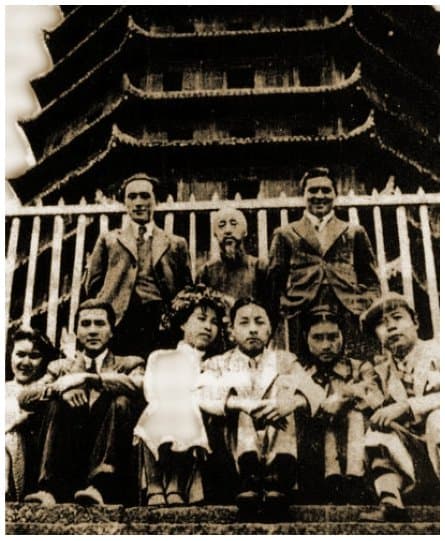 There are other
interesting stories concerning this
pagoda.
There are other
interesting stories concerning this
pagoda.
A more recent example concerns another "gang" member.
The photograph at the left shows three couples (seated) who were married at the Six Harmonies Pagoda in 1936.
All six people were famous Chinese actors and actresses at the time.
The third person from the left is "Lan Ping" (蓝苹), whose stage name translates as "Blue Apple", and her new husband "Tang Na" (唐纳).
But after the marriage, Lan Ping continued to see her former lover Yu Qiwei (俞启威). There was a public scandal and the marriage ended in divorce a couple of years later.
While Lan Ping appeared in many films and plays, she is now better known by another stage name, Jiang Qing (江青).
Following the Marco Polo Incident on July 7, 1937 and the Japanese invasion of China marking the beginning of the Second Sino-Japanese War, Jiang Qing traveled to Yan'an (延安), where the Chinese Communist Party was headquartered, in order to participate in the revolution.
While in Yan'an, she met the leader Mao Zedong (毛泽东) whom she married in 1938.
As the companion of Chairman Mao, Jiang Qing eventually obtained the position and power to rule the country as a member of the infamous "Gang of Four" (四人帮) during the "Cultural Revolution" (文化大革命 1966-1976).
Mao died on September 9, 1976. On October 6, 1976, Jiang Qing along with the other members of the "Gang of Four" were arrested and charged with subversion, counter-revolutionary activities and treason.
Jiang Qing was tried, convicted and imprisoned. She was released from prison in 1991 for medical reasons. She committed suicide on May 14, 1991.
 There are other
interesting stories concerning this
pagoda.
There are other
interesting stories concerning this
pagoda.A more recent example concerns another "gang" member.
The photograph at the left shows three couples (seated) who were married at the Six Harmonies Pagoda in 1936.
All six people were famous Chinese actors and actresses at the time.
The third person from the left is "Lan Ping" (蓝苹), whose stage name translates as "Blue Apple", and her new husband "Tang Na" (唐纳).
But after the marriage, Lan Ping continued to see her former lover Yu Qiwei (俞启威). There was a public scandal and the marriage ended in divorce a couple of years later.
While Lan Ping appeared in many films and plays, she is now better known by another stage name, Jiang Qing (江青).
Following the Marco Polo Incident on July 7, 1937 and the Japanese invasion of China marking the beginning of the Second Sino-Japanese War, Jiang Qing traveled to Yan'an (延安), where the Chinese Communist Party was headquartered, in order to participate in the revolution.
While in Yan'an, she met the leader Mao Zedong (毛泽东) whom she married in 1938.
As the companion of Chairman Mao, Jiang Qing eventually obtained the position and power to rule the country as a member of the infamous "Gang of Four" (四人帮) during the "Cultural Revolution" (文化大革命 1966-1976).
Mao died on September 9, 1976. On October 6, 1976, Jiang Qing along with the other members of the "Gang of Four" were arrested and charged with subversion, counter-revolutionary activities and treason.
Jiang Qing was tried, convicted and imprisoned. She was released from prison in 1991 for medical reasons. She committed suicide on May 14, 1991.
Longzhong Arch

This is the reverse side of the 1936 Hupeh Provincial Bank (hu bei sheng yin hang 湖北省银行) banknote with a denomination of Five Jiao (wu jiao 五角 "fifty cents") displayed in the discussion of Guqin Tai.
The vignette shows the memorial arch at Longzhong (古 隆中牌坊), located in a valley east of Mt. Longzhong in Hubei, which is the ancient residence of Zhuge Liang (诸葛亮).
Zhuge Liang (181-234) was the Prime Minister (Chancellor) of Shu Han (蜀汉) during the Three Kingdoms period (220-280). He is considered to be one of China's most outstanding military strategists and scholars and his accomplishments are immortalized in China's great historical novel the Romance of the Three Kingdoms (sanguo yanyi 三国演义) written in the 14th Century by Luo Guanzhong.
Longzhong was a secluded area but Zhuge Liang's genius was easily recognized and he earned the nickname "Wo Long" (卧龙) which translates as "sleeping dragon" or "crouching dragon".
Liu Bei (刘备, 161-223), a warlord who would later become the first emperor of Shu Han, sought the advice of Zhuge Liang but had to visit him three times before he was granted an audience. Zhuge Liang then outlined a long-term strategy for Liu Bei which became known as the Longzhong Plan.
The intrigues and warfare involved Zhuge Liang with other important historical figures of this period such as Cao Cao (曹操, 155-220), a warlord who helped establish the future kingdom of Cao Wei (曹魏), and Guan Yu (关羽, 162-219), one of Liu Bei's outstanding generals who would in later times be deified and worshipped in temples and shrines as a god in Chinese folk religions, Daoism, and Buddhism. Guan Yu is also known as the "God of War", Emperor Guan (guandi 关帝) and Guan Gong ("Lord Guan" 关公).
The Longzhong Arch was built in 1898 during the Qing Dynasty.
The three Chinese characters at the top of the middle section read gu long zhong (古隆中) which means "Ancient Longzhong".
The Chinese characters on the right section are dan bo ming zhi (淡泊明志). The left section reads ning jing zhi yuan (宁静致远). This is a famous saying of Zhuge Liang which translates as "live a simple life to show one's goal in life and live simply to express one's ambition".
On the two pillars supporting the middle section are inscribed the first two lines from a poem entitled "Prime Minister of Shu" (shu xiang 蜀相) by Du Fu (杜甫, 712-750) who was one of the greatest poets of the Tang Dynasty:
丞相祠堂何处寻,锦官城外柏森森
cheng xiang ci tang he chu xun, jin guan cheng
wai bai sen sen
Where would I find the Prime Minister's ancestral hall? Somewhere outside the Jinquan city walls in a dense cypress forest.
Where would I find the Prime Minister's ancestral hall? Somewhere outside the Jinquan city walls in a dense cypress forest.
On the back of the arch is the inscription san dai xia yi ren (三代下一人) which extols the greatness of Zhuge Liang. The inscription means "from the time of the three ancient dynasties of Xia, Shang and Zhou, there is only this man".
Golden Horse and Jade Cock Archways
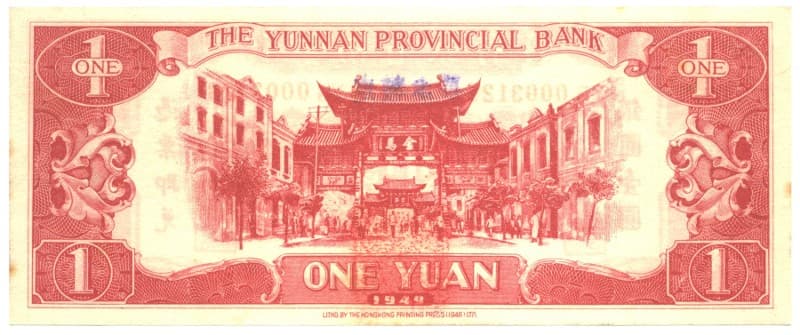
This is a One Yuan (yi yuan 壹圆 "one dollar") banknote issued in the 38th year (1949) of the Republic by The Yunnan Provincial Bank (yunnan sheng yinhang 云南省银行) and printed by the Hong Kong Printing Press (香港印字馆印务有限公司).
The vignette shows the Golden Horse Archway (jinmafang 金马坊) in the foreground and the Jade Cock Archway (bijifang 碧鸡坊) in the background. These archways are important landmarks of Kunming (混明) in Yunnan Province (云 南).
The Golden Horse (jinma 金 马) and Jade Cock (Jade Rooster, Green Rooster biji 碧鸡) are ancient symbols of Kunming. According to legend, the Golden Horse originally came from the sun and the Jade Cock came from the moon. Their arrival transformed Kunming into a lush and beautiful area full of happiness and charm.
Also, to the east of the city is the Golden Horse Mountain and to the west is the Jade Cock Mountain.
The Golden Horse and Jade Cock Archways were originally built during the Xuan De reign (1426-1435) of Emperor Xuan Zong of the Ming Dynasty. They are built on an east-west axis on Jinbi Street (jinbilu 金碧路) in Kunming and, as can be seen from the picture, are very close to each other.
The archways are 19.5 meters (64 feet) in height and 14.7 meters (48 feet) in width.
Astronomy and mathematics appear to have been important factors in their architectural design.
What is remarkable about these two archways occurs at dusk on the very rare occasions that the Chinese Mid-Autumn Festival (zhongqiujie 中秋节) falls on the same day as the autumnal equinox. On that day, as the sun sets in the west, the shadow of the Golden Horse Archway gradually lengthens to the east towards the Jade Cock Archway. At the same time, the rising moon in the east causes the shadow of the Jade Cock Archway to creep toward the west in the direction of the Golden Horse Archway.
The shadows slowly move toward each other along the street and finally overlap one another.
This phenomenon, referred to as "the sun and the moon join their brightness" (jinbijiaohui 金碧交辉), only occurs once every 60 years according to the traditional Chinese calendar based on the Ten Heavenly Stems and the Twelve Earthly Branches.
The two archways have suffered from disasters over the centuries and have had to be rebuilt several times. This has affected the phenomenon of the meeting of the shadows. For example, the shadows merged during the reign (1821-1850) of Emperor Xuan Zong (Dao Guang) but fell just short of overlapping during the reign (1875-1908) of Emperor De Zong (Guang Xu). This is attributed to the fact that the arches had to be rebuilt within the intervening 60 year period and, apparently, were not rebuilt to the proper specification.
During the Cultural Revolution (1966-1976), a large number of China's historic sites were damaged as part of the campaign to root out the "old way of thinking". The two archways did not escape this fate and, unfortunately, both were destroyed.
However, the archways were rebuilt again in 1999 and it is hoped that the wonder of the merging shadows will again occur in the future.
The
Confucius Temple and Cemetery at Qufu
Qufu (曲阜),
a city in Shandong Province (山东省),
was the capital of the State of Lu (鲁) during the
Spring and Autumn Period (770-476 BC) and was the
birthplace of Confucius
(kongzi 孔
子) who lived during the period 551-479 BC.
As one of China's greatest philosophers, Confucius is commemorated with many historical and cultural sites in Qufu including the Temple of Confucius (kong miao 孔庙), the Cemetery of Confucius (konglin 孔 林), and the Kong Family Mansion (kongfu 孔府).
As one of China's greatest philosophers, Confucius is commemorated with many historical and cultural sites in Qufu including the Temple of Confucius (kong miao 孔庙), the Cemetery of Confucius (konglin 孔 林), and the Kong Family Mansion (kongfu 孔府).
Apricot Platform
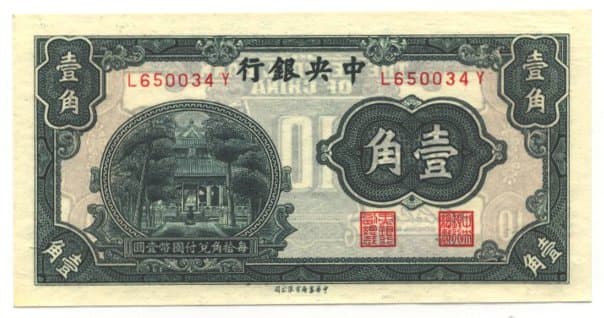
This banknote was issued in the 1920's by the Central Bank of China (zhongyang yinhang 中央银行).
The denomination is One Jiao (壹角 "ten cents") and the banknote was printed by the Chung Hua Book Company, Ltd. (zhong hua shu ju you xian gong si 中花书局有限公司).
The Temple (kong miao 孔庙) and Cemetery of Confucius (kong lin 孔林), located in Qufu, is a very large complex second in size only to the Forbidden City (zi jin cheng 紫禁城) in Beijing.
One structure in the temple complex is the Apricot Platform (xing tan 杏坛) which is displayed on this banknote. The Apricot Platform is situated in front of the "Hall of Great Achievement" (dachengdian 大成殿), also known as the "Hall of Great Accomplishment" and "Hall of Great Perfection", which is the main building at the complex and where the ancestral tablets were kept.
According to the Chinese philosopher Zhuangzi (庄子), who lived during the 4th century BC, Confucius liked to teach his disciples under an apricot tree. Based on this account, the Apricot Platform was built at the complex during the Northern Song Dynasty (960-1127).
During the Jin Dynasty (1115-1234), a pavilion was built upon the Apricot Platform.
The Apricot Platform seen in the vignette on this banknote is actually a restoration dating from the Long Qing reign of Emperor Mu Zong (1567-1572) of the Ming Dynasty.
The pavilion is supported by four vermilion pillars, occupies 12.05 square meters, and is 12.05 meters in height.
The Cemetery of Confucius
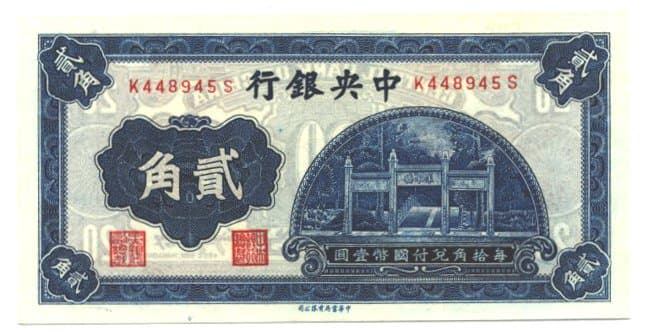
This Two Jiao (erjiao 贰角 "twenty cents") banknote was issued in 1936 by the China Central Bank (zhongyang yinhang 中央银行).
The vignette shows an archway near the entrance to the very large forest of ancient trees on the grounds of the Cemetery of Confucius (kong lin 孔林) located at Qufu in Shandong Province.
The four-post, three-arch stone archway has the inscription "Zhu River Bridge" (zhu shui qiao 洙水桥).
The small stone bridge which crosses the Zhu River can be seen just behind the archway.
The Zhu River has a strong association with Confucianism. It is said that Confucius gave discourses on his philosophy in this area of the Zhu River.
Summer Palace
Seventeen-Arch Bridge at Kunming Lake
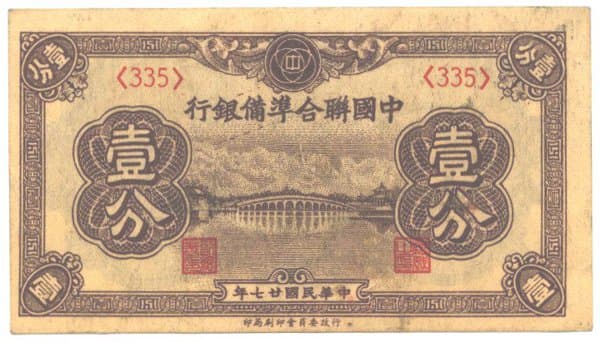
The above banknote has a denomination of One Fen (yi fen 壹分 "one cent") and was issued in 1938 by the Federal Reserve Bank of China (zhongguo lianhe zhunbei yinhang 中国联合准备银行) also known as the United Reserve Bank of China. It was printed by the Executive Committee (xingzheng weiyuanhui 行政委员会).
The "Federal Reserve Bank of China" was actually operated by the Japanese puppet government that occupied northeast China during this period.
The vignette shows the Seventeen-Arch Bridge (shiqikong qiao 十七孔桥) located on Kunming Lake (kunming hu 昆明湖) at the Summer Palace (yihe yuan 颐和园) in Beijing.
This beautiful bridge resembles a rainbow. It is made of stone and has 17 arches which get progressively larger from each end to the middle. It is 150 meters in length and 8 meters in width. The bridge's railing has carvings of 544 white marble lions and there is a "strange beast" (yi shou 异兽) carved at each end of the bridge.
The bridge, which was built during the Qian Long reign of Emperor Gao Zong (1736-1795) of the Qing (Ch'ing) Dynasty, provides a way to reach Nanhu Island (nanhu dao 南湖岛). Nanhu Island was built to symbolize Penglai (penglai xiandao 蓬莱仙岛) which was the mythical "fairyland" home of the eight Daoist (Taoist) immortals. Emperor Qin Shi Huang, who unified China in 221 BC, made several attempts during his short reign to find Penglai since the "elixir of immortality" was believed to exist there.
The number of arches (17) has an auspicious significance. Counting the arches from either end to the highest arch in the middle will result in the number "9". The Chinese word for the number "nine" (jiu 九) has the same pronunciation as the word meaning "for a long time" (jiu 久) and, therefore, would be considered a sign of respect to the emperor.
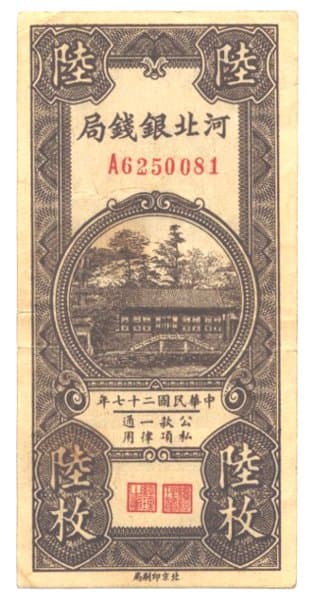
This is a "Six Copper Coins" (liu mei tongyuan 陆枚铜元)
banknote issued in the 27th year (1938) of the Republic of China
by the Ho Pei Metropolitan Bank (hebei yinhang ju 河北银行局) and printed by the
Beijing Printing Bureau (beijing
yinshua ju 北京印刷局).
The vignette is the Garden of Harmonious Interests (xiequyuan 谐趣园) at the Summer Palace (yihe yuan 颐 和园) in Beijing. A lotus pond and one of the bridges can be seen in the foreground.
The Garden of Harmonious Interests is situated at the foot of Longevity Hill (shoushan 寿山) on its eastern side.
Emperor Qianlong had this garden built in the 16th year (1751) of his reign in a classical style similar to that of the "Garden of Delight" (jichang yuan 寄畅园) in Wuxi (无锡) in Jiangsu Province (江苏省).
The garden was originally named the Huishan Garden (huishan yuan 惠山园).
In 1811, during the 16th year of the reign of Emperor Ren Zong, the garden was renovated and renamed the Garden of Harmonious Interests.
There are 13 halls and pavilions surrounding a central lotus pond and because of this, the Garden of Harmonious Interests is known as the "garden in the garden" (yuan zhong zhi yuan 圆中之园).
In 1860 the gardens were destroyed in a fire by British and French troops during the Second Opium War (1856-1860) but were rebuilt again in 1893 by Emperor De Zong.
The Empress Dowager Cixi (cixi taihou 慈禧太后), who was the de facto ruler of China from 1861-1908, loved to spend time at the Garden of Harmonious Interests observing the scenery around the lotus pond and fishing.
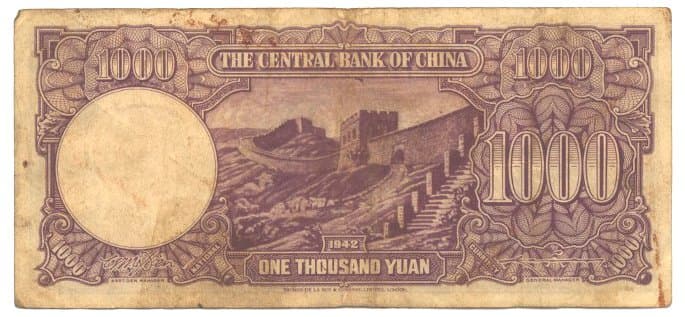
This denomination "1000 Yuan" (yi qian yuan 壹仟圆 "one thousand dollars") note was issued in 1942 by the Central Bank of China (zhongyang yinhang 中 央银行) and was printed by Thomas de La Rue & Company, Limited, London.
The vignette shows the Great Wall of China (changcheng 长城 or wanlichangcheng 万里长城) which stretches approximately 6,230 kilometers (3,890 miles) from Shanhaiguan (山海关) in the east, where the wall meets the Bohai Sea (Pacific Ocean), to the salt lake marshes and desert of Xinjiang's Lop Nor (罗布泊) in the west.
Construction of the Great Wall began with the unification of China in 221 BC by the "First Emperor", Qin Shi Huang (秦始皇), and was built to protect China's northern border from the Xiongnu (匈奴) which were nomadic tribes from central and eastern Asia.
The wall was built of rammed earth, bricks and stones.
The last major construction of the wall for defensive purposes took place during the Ming Dynasty and helped defend attacks from the Manchus.
Shanhaiguan (Shanhai Pass)
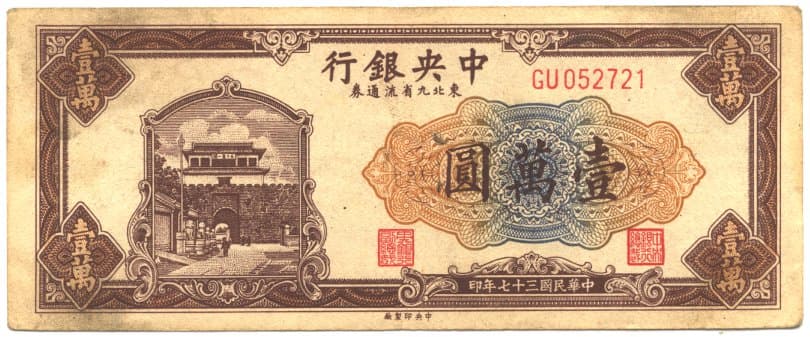
This is a Ten Thousand Yuan (yi wan yuan 壹万元 "$10,000") banknote issued in the 37th year (1948) of the Republic by the Central Bank of China (zhongyang yinhang 中央银行) and printed by the Central Printing Factory (zhongyang yinzhichang 中央印制厂).
The smaller Chinese inscription below the bank name at the top center of the bill indicates that it is a special issue meant to circulate only in the "nine provinces of the Northeast" (dongbei jiusheng liutongquan 东北九省流通券), known as "Manchuria", that the Chinese nationalists recovered late in World War II from the occupying Japanese forces.
The vignette on the left shows the "Shanhai Pass" or Shanhaiguan (山海关) which is located at the eastern end of the Great Wall in the city of Qinhuangdao (秦皇岛) in Hebei Province (河北).
While passes had existed here since the time of the Northern Qi Dynasty (550-577) of the Northern Dynasties and the Tang Dynasty (618-907), the present pass was built by General Xu Da (徐达) beginning in the year 1381 during the Ming Dynasty (1368-1644).
"Shanhaiguan" is derived from the Chinese word "shan" (山) meaning "mountains", "hai" (海) meaning "sea", and "guan" (关) meaning "pass". The name is appropriate since the pass is situated between the mountains and the Bohai Sea.
Shanhaiguan was originally a square with walls 14 meters high and 7 meters thick. It had a perimeter of 4 kilometers surrounded by a moat with drawbridges and with a gate on each side. However, the only surviving gate is the Zhendong Gate (镇东楼) which is the eastern gate depicted in the vignette on this banknote.
Shanhaiguan has been the site of many battles over the centuries including crucial ones at the end of the Ming Dynasty, during the Eight-Nation Alliance (bagualianjun 八国联军) of 1900, and World War II.
Near the top of the gate can be seen the sign stating that Shanhaiguan is the "First Pass under Heaven" (tian xia di yi guan 天下第一关).
Yumenkou
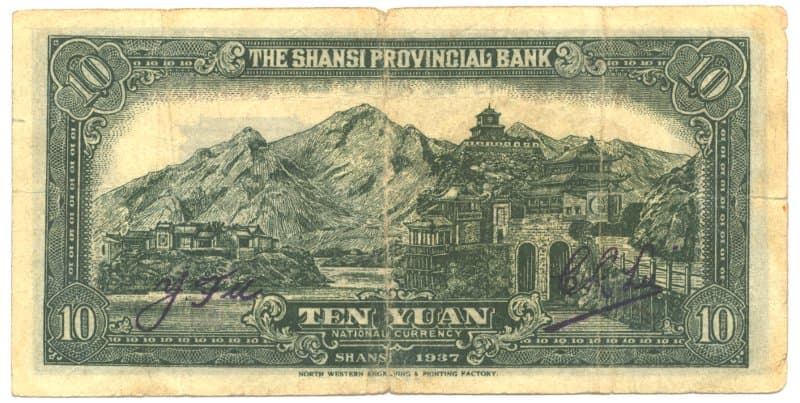
This is the reverse side of a Ten Yuan ("ten dollar" shi yuan 拾元) banknote issued in 1937 by the Shansi Provincial Bank (shanxi sheng yinhang 山西省银行) and printed by the North Western Engraving and Printing Factory (xibei yinshua chang 西北印刷厂).
The vignette displays the "Dragon Gate" (longmen 龙 门), also known as "Yu's Doorway" (yumenkou 禹 门口), which is a very narrow gorge through which the Yellow River (huanghe 黄河) must flow. The Dragon Gate separates Shanxi Province (山西省) from Shaanxi Province (陕西省).
 At the left is an old undated
photograph of the Dragon Gate from a Chinese
government website.
At the left is an old undated
photograph of the Dragon Gate from a Chinese
government website.
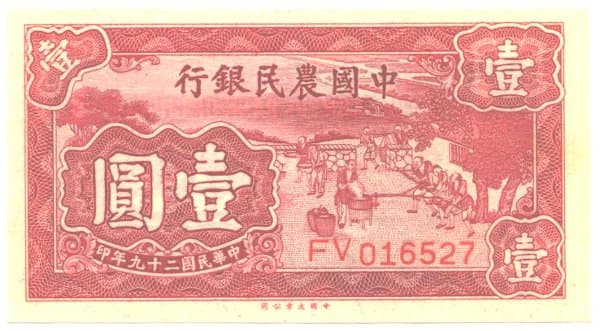
The banknote shown above has a denomination of One Yuan (壹 圆 "one dollar") and was issued in the 29th year (1940) of the Republic of China by The Farmers Bank of China (zhongguo nongmin yinhang 中国农民银行). The note was printed by the Zhongguo Daye Gongsi (中国大业公司).
The vignette shows a group of farmers, with crop fields in the background, busy grinding grain with a stone grinder.
Return to Ancient Chinese Charms and Coins
The vignette is the Garden of Harmonious Interests (xiequyuan 谐趣园) at the Summer Palace (yihe yuan 颐 和园) in Beijing. A lotus pond and one of the bridges can be seen in the foreground.
The Garden of Harmonious Interests is situated at the foot of Longevity Hill (shoushan 寿山) on its eastern side.
Emperor Qianlong had this garden built in the 16th year (1751) of his reign in a classical style similar to that of the "Garden of Delight" (jichang yuan 寄畅园) in Wuxi (无锡) in Jiangsu Province (江苏省).
The garden was originally named the Huishan Garden (huishan yuan 惠山园).
In 1811, during the 16th year of the reign of Emperor Ren Zong, the garden was renovated and renamed the Garden of Harmonious Interests.
There are 13 halls and pavilions surrounding a central lotus pond and because of this, the Garden of Harmonious Interests is known as the "garden in the garden" (yuan zhong zhi yuan 圆中之园).
In 1860 the gardens were destroyed in a fire by British and French troops during the Second Opium War (1856-1860) but were rebuilt again in 1893 by Emperor De Zong.
The Empress Dowager Cixi (cixi taihou 慈禧太后), who was the de facto ruler of China from 1861-1908, loved to spend time at the Garden of Harmonious Interests observing the scenery around the lotus pond and fishing.
Great Wall of China

This denomination "1000 Yuan" (yi qian yuan 壹仟圆 "one thousand dollars") note was issued in 1942 by the Central Bank of China (zhongyang yinhang 中 央银行) and was printed by Thomas de La Rue & Company, Limited, London.
The vignette shows the Great Wall of China (changcheng 长城 or wanlichangcheng 万里长城) which stretches approximately 6,230 kilometers (3,890 miles) from Shanhaiguan (山海关) in the east, where the wall meets the Bohai Sea (Pacific Ocean), to the salt lake marshes and desert of Xinjiang's Lop Nor (罗布泊) in the west.
Construction of the Great Wall began with the unification of China in 221 BC by the "First Emperor", Qin Shi Huang (秦始皇), and was built to protect China's northern border from the Xiongnu (匈奴) which were nomadic tribes from central and eastern Asia.
The wall was built of rammed earth, bricks and stones.
The last major construction of the wall for defensive purposes took place during the Ming Dynasty and helped defend attacks from the Manchus.
Shanhaiguan (Shanhai Pass)

This is a Ten Thousand Yuan (yi wan yuan 壹万元 "$10,000") banknote issued in the 37th year (1948) of the Republic by the Central Bank of China (zhongyang yinhang 中央银行) and printed by the Central Printing Factory (zhongyang yinzhichang 中央印制厂).
The smaller Chinese inscription below the bank name at the top center of the bill indicates that it is a special issue meant to circulate only in the "nine provinces of the Northeast" (dongbei jiusheng liutongquan 东北九省流通券), known as "Manchuria", that the Chinese nationalists recovered late in World War II from the occupying Japanese forces.
The vignette on the left shows the "Shanhai Pass" or Shanhaiguan (山海关) which is located at the eastern end of the Great Wall in the city of Qinhuangdao (秦皇岛) in Hebei Province (河北).
While passes had existed here since the time of the Northern Qi Dynasty (550-577) of the Northern Dynasties and the Tang Dynasty (618-907), the present pass was built by General Xu Da (徐达) beginning in the year 1381 during the Ming Dynasty (1368-1644).
"Shanhaiguan" is derived from the Chinese word "shan" (山) meaning "mountains", "hai" (海) meaning "sea", and "guan" (关) meaning "pass". The name is appropriate since the pass is situated between the mountains and the Bohai Sea.
Shanhaiguan was originally a square with walls 14 meters high and 7 meters thick. It had a perimeter of 4 kilometers surrounded by a moat with drawbridges and with a gate on each side. However, the only surviving gate is the Zhendong Gate (镇东楼) which is the eastern gate depicted in the vignette on this banknote.
Shanhaiguan has been the site of many battles over the centuries including crucial ones at the end of the Ming Dynasty, during the Eight-Nation Alliance (bagualianjun 八国联军) of 1900, and World War II.
Near the top of the gate can be seen the sign stating that Shanhaiguan is the "First Pass under Heaven" (tian xia di yi guan 天下第一关).
Dragon Gate
Yumenkou

This is the reverse side of a Ten Yuan ("ten dollar" shi yuan 拾元) banknote issued in 1937 by the Shansi Provincial Bank (shanxi sheng yinhang 山西省银行) and printed by the North Western Engraving and Printing Factory (xibei yinshua chang 西北印刷厂).
The vignette displays the "Dragon Gate" (longmen 龙 门), also known as "Yu's Doorway" (yumenkou 禹 门口), which is a very narrow gorge through which the Yellow River (huanghe 黄河) must flow. The Dragon Gate separates Shanxi Province (山西省) from Shaanxi Province (陕西省).
 At the left is an old undated
photograph of the Dragon Gate from a Chinese
government website.
At the left is an old undated
photograph of the Dragon Gate from a Chinese
government website.The "Yu" in "Yu's
Doorway" refers to "Yu the Great"
(dayu 大禹) who
was the legendary founder of the Xia Dynasty (21st
century - 16th century BC).
One of Yu's greatest achievements was his monumental
work in controlling the floods (dayu zhi shui 大禹治水) that,
unfortunately, continued to plague China throughout its
history.
There was a large-scale flood four thousand years ago. As described in the Book of History (shangshu 尚书), also known as the Classic of History (shujing 书经), "Destructive in their spread are the waters of the deluge. In their vastness they embrace the mountains, submerge the hills and rise to the heavens with their swell."
Efforts to contain the floodwaters using dykes failed. Yu decided to control the waters by creating channels instead. The Yellow River was seriously obstructed near Mount Longmen ("Mount Dragon Gate" longmen shan 龙门山) so Yu had the very narrow opening enlarged to allow the Yellow River to flow more easily to the sea and thereby provide relief to the flooding upstream. This is the origin of the name "Yu's Doorway" or "Dragon Gate".
As already mentioned, the Dragon Gate is very narrow and has steep cliffs. In some places it is only about 80 meters across so it squeezes the Yellow River into a raging torrent. This results in a scene of large waves with a loud roar and dense mist.
The cities of Hejin (河津), on the east bank in Shanxi Province, and Hancheng (韩城), on the west bank in Shaanxi Province, face each other on the opposite cliffs of the Dragon Gate gorge. Ancient temples honoring "Yu the Great" were built on both sides of the river.
Hancheng is also famous as the birthplace of Sima Qian (司马迁) (145 BC - 86 BC) who was the great historian of the Han Dynasty.
The Dragon Gate is also renown for the Hukou Waterfall (壶口瀑布), the second largest waterfall in China, which is associated with the Chinese proverb the "Carp leaps over the Dragon Gate" (liyutiaolongmen 鲤鱼跳龙门). To continue the journey down the Yellow River, a carp fish must traverse this waterfall. Since the challenge is so great, very few fish succeed. According to the myth, a carp fish that can jump over the waterfall is transformed into a "dragon".
The "Carp leaps over the Dragon Gate" has the implied meaning that persistent effort is needed to overcome obstacles. The metaphor was frequently used in ancient times to describe those who were successful in passing the imperial examinations to become high government officials.
Unfortunately, most of the ancient buildings of the Dragon Gate shown in the above images were destroyed in battles between Japanese and Chinese troops during World War II. The area is now dominated by the Yellow River's shortest bridge known as the Yumenkou Yellow River Bridge.
The obverse side of this banknote has a vignette of the Taiyuan Drum Tower which is discussed in detail above.
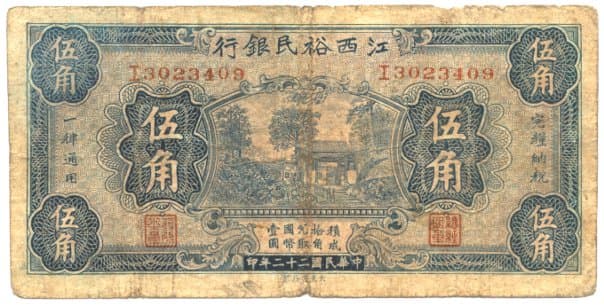
There was a large-scale flood four thousand years ago. As described in the Book of History (shangshu 尚书), also known as the Classic of History (shujing 书经), "Destructive in their spread are the waters of the deluge. In their vastness they embrace the mountains, submerge the hills and rise to the heavens with their swell."
Efforts to contain the floodwaters using dykes failed. Yu decided to control the waters by creating channels instead. The Yellow River was seriously obstructed near Mount Longmen ("Mount Dragon Gate" longmen shan 龙门山) so Yu had the very narrow opening enlarged to allow the Yellow River to flow more easily to the sea and thereby provide relief to the flooding upstream. This is the origin of the name "Yu's Doorway" or "Dragon Gate".
As already mentioned, the Dragon Gate is very narrow and has steep cliffs. In some places it is only about 80 meters across so it squeezes the Yellow River into a raging torrent. This results in a scene of large waves with a loud roar and dense mist.
The cities of Hejin (河津), on the east bank in Shanxi Province, and Hancheng (韩城), on the west bank in Shaanxi Province, face each other on the opposite cliffs of the Dragon Gate gorge. Ancient temples honoring "Yu the Great" were built on both sides of the river.
Hancheng is also famous as the birthplace of Sima Qian (司马迁) (145 BC - 86 BC) who was the great historian of the Han Dynasty.
The Dragon Gate is also renown for the Hukou Waterfall (壶口瀑布), the second largest waterfall in China, which is associated with the Chinese proverb the "Carp leaps over the Dragon Gate" (liyutiaolongmen 鲤鱼跳龙门). To continue the journey down the Yellow River, a carp fish must traverse this waterfall. Since the challenge is so great, very few fish succeed. According to the myth, a carp fish that can jump over the waterfall is transformed into a "dragon".
The "Carp leaps over the Dragon Gate" has the implied meaning that persistent effort is needed to overcome obstacles. The metaphor was frequently used in ancient times to describe those who were successful in passing the imperial examinations to become high government officials.
Unfortunately, most of the ancient buildings of the Dragon Gate shown in the above images were destroyed in battles between Japanese and Chinese troops during World War II. The area is now dominated by the Yellow River's shortest bridge known as the Yumenkou Yellow River Bridge.
The obverse side of this banknote has a vignette of the Taiyuan Drum Tower which is discussed in detail above.
White Deer Grotto Academy

The old banknote
shown above has a denomination of Five
Jiao (wu jiao
五角 "fifty cents") and was issued in the 22nd
year (1933) of the Republic by The Yu Ming Bank of
Kiangsi (Chiang Hsi Yu Min Yin Hang jiangxi yumin yinhang
江西裕民银行). The note was printed by Ta Tung
Printing (da dong
shu ju 大东书局).
The picture shows the White Deer Grotto Academy (bailudong shuyuan 白鹿洞书院), also known as the White Deer Cave Academy or White Deer Hollow Academy. The school is located in the midst of a luxuriantly green forest at the base of Five Old Men Peak (wulaofeng 五老峰) of Mount Lu (lushan 庐山) in Jiangxi Province (江西).
During the Tang Dynasty (618-907), the poet Li Bo (李渤) and his brothers lived there in seclusion. The local villagers informally named the valley the "White Deer Grotto" because the brothers raised white deer in the area.
The White Deer Grotto National School (bailudong guoxue 白鹿洞国学) was established during the years 937-942 of the Southern Tang (nan tang 南唐). The school became the White Deer Grotto Academy during the early Northern Song Dynasty (960-1127) but not long afterwards was abandoned.
Zhu Xi (Chu Hsi 朱熹 1130-1200), one of the most famous Confucian scholars of the Song Dynasty, began to rebuild and expand the school in the 6th year (1179) of the Chun Xi (淳 熙) reign of the Southern Song. Books were collected, teachers and students were recruited, and a curriculum was established. Zhu Xi served both as the head of the Academy as well as one of the lecturers.
The White Deer Grotto Academy was recognized as one of the Four Great Academies (si da shu yuan 四大书院) of the Song Dynasty. The other three schools were the Yingtianfu Academy (应天府书院), the Yuelu Academy (岳麓书院) and the Shigu Academy (石鼓书院).
Wang Yangming (王阳明 1472-1529), considered to be the second most important Neo-Confucian scholar after Zhu Xi, also taught classes at the White Deer Grotto Academy during the Ming Dynasty.
The academy continued to provide the highest level of education for eight centuries and was completely renovated during the 1980's.
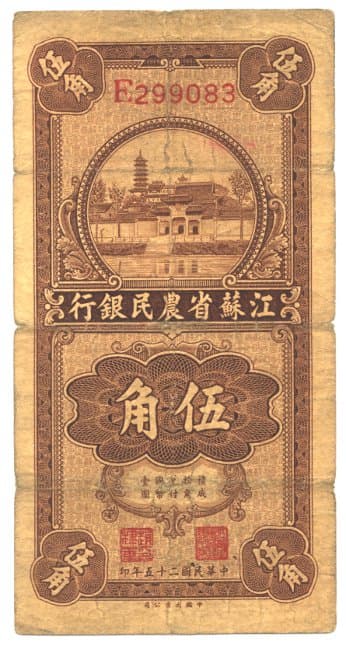
This is a Five Jiao (wu jiao 五 角 "50 cents") banknote issued in the 25th year (1936) of the Republic by the Kiangsu Farmers Bank (jiangsusheng nongmin yinhang 江苏省农民银行) and printed by the China Ta Ye Company (zhongguo daye gongsi 中国大业公司).
The vignette shows the famous Jin Shan (Gold Mountain or Golden Hill) Temple (jinshansi 金山寺) and Ci Shou Pagoda (cishouta 慈寿塔) which are situated on Jin Shan (Gold Mountain).
According to legend, Gold Mountain obtained its name when Fa Hai (法 海), a Buddhist monk who had studied at Lushan and was the son of a Tang Dynasty prime minister, discovered a pot of gold there. Fa Hai gave the gold to the local officials but the emperor ordered that the gold be returned to Fa Hai to be used to rebuild the temple.
Gold Mountain was originally a small island in the middle of the Yangtze River (changjiang 长江) near Zhenjiang City (镇江) in Jiangsu Province (江苏) but during the last several centuries the island has gradually merged with the riverbank.
Gold Mountain is famous for two reasons. Gold Mountain was where Liang Hongyu, a female soldier, helped direct the army of the Song Dynasty to victory over the forces of the Jin by beating out commands on a large war drum. Gold Mountain also played a prominent role in the Chinese folktale "The Legend of the White Snake".
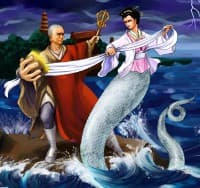 The
"Legend of the White Snake" (baishezhuan
白蛇传) is a very ancient Chinese story
that tells of a young scholar by the
name of Xu Xian (许仙) who falls in love
and marries a beautiful girl named Lady
White (Madam White, Madam Bai, Bai Suzhen
白素贞). Unbeknownst to him, his
bride was actually a 1,000-year old
white snake demon who wanted to do good
deeds in the world.
The
"Legend of the White Snake" (baishezhuan
白蛇传) is a very ancient Chinese story
that tells of a young scholar by the
name of Xu Xian (许仙) who falls in love
and marries a beautiful girl named Lady
White (Madam White, Madam Bai, Bai Suzhen
白素贞). Unbeknownst to him, his
bride was actually a 1,000-year old
white snake demon who wanted to do good
deeds in the world.
Fa Hai (法海) was a Buddhist monk who lived at Gold Mountain Temple. He discovered that Lady White was a snake demon and tried to warn Xu Xian. Xu Xian refused to believe him and Fa Hai imprisoned him at Gold Mountain Temple.
Lady White went to Gold Mountain Temple to confront Fa Hai. Fa Hai refused to release Xu Xian whereupon Lady White used her supernatural powers to create a flood at the temple. Fa Hai then used a magic bowl to capture Lady White and imprisoned her beneath the Leifeng Pagoda (雷峰塔) located at West Lake (xihu 西湖) in Hangzhou (杭州).
Xiao Qing (小青), a green snake demon and the sister of Lady White, was in the end able to defeat Fa Hai and free Lady White from Leifeng Pagoda. Xu Xian and Lady White were again able to live happily together.
The illustration above shows the Buddhist monk Fa Hai battling Lady White during the flooding of Jin Shan Temple. In Fa Hai's right hand is the magic bowl he used to capture Lady White. In the background can be seen the Jin Shan Temple and pagoda.
Over the centuries, "The Legend of the White Snake" has been retold in various versions and in many forms including a Chinese opera.
The temple on Gold Mountain was first built during the Eastern Jin Dynasty (dongjin 东晋 317-420) and was then known as the Zexin Temple (zexinsi 泽心寺).
By the Tang Dynasty (618-907), the temple had become known as the Gold Mountain Temple and during its heyday was the home of 3,000 Buddhish monks.
The temple complex extends from the foot to the top of the hill which is crowned by the seven-story eight-sided brick "Ci Shou Pagoda". The temple halls are built around the hill in such a manner that from a distance only the temple complex, and not the hill, can be seen. Local residents say that "the temple wraps the hill" (jinshansi guo shan 金山寺裹山).
The Ci Shou Pagoda was first built during the Southern Dynasties (nanchao 南朝 420-589) but the present pagoda is a restoration dating from the reign of Emperor Guangxu (1875-1908) of the Qing (Ch'ing) Dynasty.
Jin Shan Temple houses several treasures including a bronze drum which is believed to have belonged to Zhuge Liang. The drum was designed to be used as a cooking pot when not being used in combat. The temple also has the official jade mandarin belt worn by Su Dongpo (苏东坡 1037-1101), an important poet of the Song Dynasty.
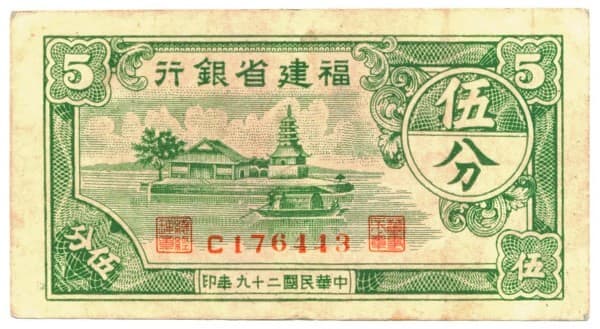
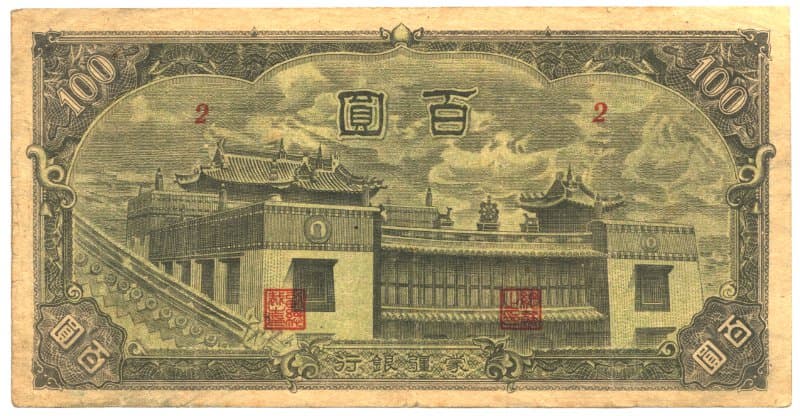
This "100 Yuan" (bai yuan 百元 "100 dollars")
banknote was issued by the Mengchiang Bank (mengjiang yinhang
蒙疆银行) in the 26th year (1937) of the
Republic and was printed by the Japan Imperial
Cabinet Bureau of Printing (riben neige yihshuaju 日本内阁印刷局).
The "Mengchiang Bank" or "Inner-Mongolian Bank" was one of the banks established by the Japanese during their invasion and occupation of China.
The vignette shows "Xilituzhao" (席力图召), also known as the "Xilitu Temple", "Xilituzhao Lamasery" and "Shireet� zuu". It is located in Hohhot (呼和浩特), Inner Mongolia (neimengu 内蒙古).
Even though it is commonly referred to as "little temple" (xiao zhao 小召), it is actually the largest Lama temple in the old city.
"Xilitu" (席力图) means "Holy Seat (of Dalai Lama)" in Tibetan and "zhao" (召) is the Mongolian word for "temple".
In 1578 during the early years of the Wan Li reign of Emperor Shen Zong (1573-1620) of the Ming Dynasty, the Altan Khan (俺答汗) (1507-1582), who was the prince of the Mongolian T�med tribe, met with the Tibetan lama Sonam Gyatso (索南嘉错) and bestowed upon him the title "Dalai Lama" (达赖喇嘛). Sonam Gyatso was the first officially recognized Dalai Lama but became the "3rd Dalai Lama" after the title was later bestowed upon two predecessors.
Sonam Gyatso was a monk of the Tibetan Gelugpa (格鲁派) or "Yellow Hat" school of Buddhism and together with Altan Khan gradually converted the Mongols from their traditional shamanism to Tibetan Buddhism.
Altan Khan built a number of Buddhist temples in the capital city of Kh�kh Khot (Hohhot) including the Xilituzhao Temple.
Yonten Gyatso (1589-1617), the great-grandson of Altan Khan, became the 4th Dalai Lama. Born a Mongolian, Yonten Gyatso has been the only non-Tibetan to ever become a Dalai Lama.
Yonten Gyatso began his religious studies at Xilituzhao Temple, which was the home of his tutor Huofu Xitiuke, before leaving for Tibet in 1599 at the age of ten.
This Buddhist Lama Temple of Xilitu Zhao was built in the Tibetan style and was greatly expanded during the Qing Dynasty.
If you look carefully at the roof above the middle section of the temple, you will see on pedestals a Buddhist Wheel of Dharma with two deer, one on each side. The Wheel of Dharma symbolizes "knowledge". The Wheel of Dharma together with the two deer represents the Buddha's first turning of the Wheel of Dharma at Deer Park in Sarnath, India.
Behind the Wheel of Dharma, but which unfortunately cannot be seen in the vignette, are two victory banners as well as a jeweled trident.
The victory banners are symbols proclaiming that the Buddha's teachings conquer all.
The jeweled trident represents the Three Buddhas (past, present and future). The Three Jewels can be interpreted as "the Buddha, the doctrine, and the monastic community" or the "body, speech and mind".
The Wheel of Dharma and the victory banner are two of the Eight Treasures of Buddhism.
Since 1735, Xilituzhao Temple has been the official residence of the Living Buddha who is responsible for all Buddhist activities for the city.
This is a 100 Yuan (yi bai yuan 壹百元 "$100") banknote issued in the 27th year (1938) of the Republic by the Federal Reserve Bank of China (zhongguo lianhe zhunbei yinhang 中国联合准备银行), also known as the United Reserve Bank of China, and printed by the Executive Committee (xingzheng weiyuanhui 行政委员会).
The "Federal Reserve Bank of China" was one of the banks operated by the Japanese puppet government that occupied northeast China during the Second World War.
The vignette on the right side is the legendary "Yellow Emperor" (huangdi 黄帝) who is considered the founder of the Chinese civilization and one of the "Three Sovereigns and Five Emperors". He was believed to have reigned from 2696 BC - 2598 BC.
The Yellow Emperor is credited with teaching the people how to build homes, grow crops, and tame wild animals. He invented clothing, carts, boats, the south-pointing chariot and the Chinese musical instrument known as the guqin. He commanded one of his officials to invent the first Chinese writing system which is the script used on oracle bones. He also helped establish the Chinese calendar, early Chinese astronomy, and traditional Chinese medicine.
His wife, Lady Xiling (Lady Xi Ling Shi, leizu 祖祖), is recognized as discovering silk and the inventor of the silk loom.
This is a One Yuan (yi yuan 壹元 "$1") banknote issued by the Federal Reserve Bank of China (zhongguo lianhe zhunbei yinhang 中国联合准备银行), also known as the United Reserve Bank of China, and printed by the North China Printing Office (huabei zhengwu weiyuanhui yinshuaju 华北政务委员会印刷局).
There is no date on this banknote but the "Federal Reserve Bank of China" was a Japanese puppet government bank that printed paper money during the years 1938-1945.
The portrait on the right is Confucius and the vignette on the left is the Temple of Confucius (Confucius Temple kong miao孔庙) located at Confucius' hometown of Qufu in Shandong Province.
Confucius (Kong Fuzi 孔夫子), who lived from 551 BC to 479 BC, was one of China's most famous philosophers and educators. His teachings, which he believed were lessons transmitted from very ancient times, became the moral foundation for Chinese society and government for more than two thousand years.
The Confucian concepts of righteousness and filial piety, illustrated by old Chinese charms, are discussed in detail at Confucian Charms.
The Confucian Temple at Qufu is the largest and oldest temple dedicated to the great philosopher. Other Chinese banknotes with vignettes of the Apricot Platform and Cemetery of Confucius are displayed above.
This is a Five Jiao (wu jiao 五角 "50 cents") banknote issued by the Central Bank of Manchuria also known as the Central Bank of Manchukuo (manzhou zhongyang yinhang 满洲中央银行).
The Central Bank of Manchuria, along with the Federal Reserve Bank of China, were banks created under the Japanese puppet state of Manchukuo in northeastern China. The Japanese created the Central Bank of Manchuria by annexing the Manchurian Provincial Bank, the Yongheng Government Bank of Jilin Province, the Government Bank of Heilongjiang Province and the Frontier Bank.
There is no date of issue printed on the note although it is believed that these banknotes were issued beginning in 1937. Also, the printer is not indicated on the note.
The portrait depicts Emperor Qianlong (Emperor Gao Zong) who reigned during the years 1736-1795 of the Qing (Ch'ing) Dynasty.
Emperor Qianlong is credited with using his military to expand China's borders. He was also a great patron of arts.
Dragons with five claws, symbolizing the emperor, form the right and left borders of the note. Another dragon is depicted on the chest of the emperor.
Emperor Qianlong is also shown holding a ruyi sceptre on his right.
The picture shows the White Deer Grotto Academy (bailudong shuyuan 白鹿洞书院), also known as the White Deer Cave Academy or White Deer Hollow Academy. The school is located in the midst of a luxuriantly green forest at the base of Five Old Men Peak (wulaofeng 五老峰) of Mount Lu (lushan 庐山) in Jiangxi Province (江西).
During the Tang Dynasty (618-907), the poet Li Bo (李渤) and his brothers lived there in seclusion. The local villagers informally named the valley the "White Deer Grotto" because the brothers raised white deer in the area.
The White Deer Grotto National School (bailudong guoxue 白鹿洞国学) was established during the years 937-942 of the Southern Tang (nan tang 南唐). The school became the White Deer Grotto Academy during the early Northern Song Dynasty (960-1127) but not long afterwards was abandoned.
Zhu Xi (Chu Hsi 朱熹 1130-1200), one of the most famous Confucian scholars of the Song Dynasty, began to rebuild and expand the school in the 6th year (1179) of the Chun Xi (淳 熙) reign of the Southern Song. Books were collected, teachers and students were recruited, and a curriculum was established. Zhu Xi served both as the head of the Academy as well as one of the lecturers.
The White Deer Grotto Academy was recognized as one of the Four Great Academies (si da shu yuan 四大书院) of the Song Dynasty. The other three schools were the Yingtianfu Academy (应天府书院), the Yuelu Academy (岳麓书院) and the Shigu Academy (石鼓书院).
Wang Yangming (王阳明 1472-1529), considered to be the second most important Neo-Confucian scholar after Zhu Xi, also taught classes at the White Deer Grotto Academy during the Ming Dynasty.
The academy continued to provide the highest level of education for eight centuries and was completely renovated during the 1980's.
Temples
Jin Shan (Gold Mountain) Temple

This is a Five Jiao (wu jiao 五 角 "50 cents") banknote issued in the 25th year (1936) of the Republic by the Kiangsu Farmers Bank (jiangsusheng nongmin yinhang 江苏省农民银行) and printed by the China Ta Ye Company (zhongguo daye gongsi 中国大业公司).
The vignette shows the famous Jin Shan (Gold Mountain or Golden Hill) Temple (jinshansi 金山寺) and Ci Shou Pagoda (cishouta 慈寿塔) which are situated on Jin Shan (Gold Mountain).
According to legend, Gold Mountain obtained its name when Fa Hai (法 海), a Buddhist monk who had studied at Lushan and was the son of a Tang Dynasty prime minister, discovered a pot of gold there. Fa Hai gave the gold to the local officials but the emperor ordered that the gold be returned to Fa Hai to be used to rebuild the temple.
Gold Mountain was originally a small island in the middle of the Yangtze River (changjiang 长江) near Zhenjiang City (镇江) in Jiangsu Province (江苏) but during the last several centuries the island has gradually merged with the riverbank.
Gold Mountain is famous for two reasons. Gold Mountain was where Liang Hongyu, a female soldier, helped direct the army of the Song Dynasty to victory over the forces of the Jin by beating out commands on a large war drum. Gold Mountain also played a prominent role in the Chinese folktale "The Legend of the White Snake".
Liang Hongyu
Liang Hongyu
(梁红玉) was a courtesan who caught the eye
of Han Shizong (韩世忠) who would later
become a general in the Song Dynasty army.
In 1129, General Han was in charge of an army of 8,000 troops facing an army of Jin Dynasty (1115-1234) troops numbering 100,000.
As his wife, Liang Hongyu devised a clever plan to defeat the Jin army. She was an expert drummer and had a large war drum placed on Gold Mountain which she then used, along with signal flags, to communicate commands to the Song army.
Her plan proved to be successful and the Song army was able to defeat the much larger Jin army.
In 1129, General Han was in charge of an army of 8,000 troops facing an army of Jin Dynasty (1115-1234) troops numbering 100,000.
As his wife, Liang Hongyu devised a clever plan to defeat the Jin army. She was an expert drummer and had a large war drum placed on Gold Mountain which she then used, along with signal flags, to communicate commands to the Song army.
Her plan proved to be successful and the Song army was able to defeat the much larger Jin army.
The Legend of the White Snake
 The
"Legend of the White Snake" (baishezhuan
白蛇传) is a very ancient Chinese story
that tells of a young scholar by the
name of Xu Xian (许仙) who falls in love
and marries a beautiful girl named Lady
White (Madam White, Madam Bai, Bai Suzhen
白素贞). Unbeknownst to him, his
bride was actually a 1,000-year old
white snake demon who wanted to do good
deeds in the world.
The
"Legend of the White Snake" (baishezhuan
白蛇传) is a very ancient Chinese story
that tells of a young scholar by the
name of Xu Xian (许仙) who falls in love
and marries a beautiful girl named Lady
White (Madam White, Madam Bai, Bai Suzhen
白素贞). Unbeknownst to him, his
bride was actually a 1,000-year old
white snake demon who wanted to do good
deeds in the world.Fa Hai (法海) was a Buddhist monk who lived at Gold Mountain Temple. He discovered that Lady White was a snake demon and tried to warn Xu Xian. Xu Xian refused to believe him and Fa Hai imprisoned him at Gold Mountain Temple.
Lady White went to Gold Mountain Temple to confront Fa Hai. Fa Hai refused to release Xu Xian whereupon Lady White used her supernatural powers to create a flood at the temple. Fa Hai then used a magic bowl to capture Lady White and imprisoned her beneath the Leifeng Pagoda (雷峰塔) located at West Lake (xihu 西湖) in Hangzhou (杭州).
Xiao Qing (小青), a green snake demon and the sister of Lady White, was in the end able to defeat Fa Hai and free Lady White from Leifeng Pagoda. Xu Xian and Lady White were again able to live happily together.
The illustration above shows the Buddhist monk Fa Hai battling Lady White during the flooding of Jin Shan Temple. In Fa Hai's right hand is the magic bowl he used to capture Lady White. In the background can be seen the Jin Shan Temple and pagoda.
Over the centuries, "The Legend of the White Snake" has been retold in various versions and in many forms including a Chinese opera.
The temple on Gold Mountain was first built during the Eastern Jin Dynasty (dongjin 东晋 317-420) and was then known as the Zexin Temple (zexinsi 泽心寺).
By the Tang Dynasty (618-907), the temple had become known as the Gold Mountain Temple and during its heyday was the home of 3,000 Buddhish monks.
The temple complex extends from the foot to the top of the hill which is crowned by the seven-story eight-sided brick "Ci Shou Pagoda". The temple halls are built around the hill in such a manner that from a distance only the temple complex, and not the hill, can be seen. Local residents say that "the temple wraps the hill" (jinshansi guo shan 金山寺裹山).
The Ci Shou Pagoda was first built during the Southern Dynasties (nanchao 南朝 420-589) but the present pagoda is a restoration dating from the reign of Emperor Guangxu (1875-1908) of the Qing (Ch'ing) Dynasty.
Jin Shan Temple houses several treasures including a bronze drum which is believed to have belonged to Zhuge Liang. The drum was designed to be used as a cooking pot when not being used in combat. The temple also has the official jade mandarin belt worn by Su Dongpo (苏东坡 1037-1101), an important poet of the Song Dynasty.

This is a
Five Fen (wu fen 伍分 "5 cents")
banknote issued in the 29th year (1940) of
the Republic by the Fukien Provincial Bank
(fujiansheng
yinhang 福洲省银行).
The vignette shows a pagoda and temple on a small island located in the middle of the Wulong River (乌龙江), which is a branch of the Min River (闽江), near the village of Hongtong (洪塘村) in the western suburb of the city of Fuzhou (福洲) in Fujian Province (福建).
The island is very small and rises only several meters above the river.
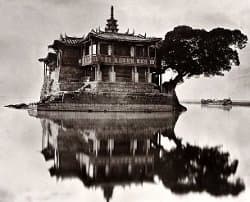 At the left is
a photograph, taken by the Scottish
photographer John Thomson, of what the
temple looked like in the year 1879.
The photo shows the island from a
different angle and illustrates how the
temple with the pagoda in the back appears
to "float" serenely on the water.
At the left is
a photograph, taken by the Scottish
photographer John Thomson, of what the
temple looked like in the year 1879.
The photo shows the island from a
different angle and illustrates how the
temple with the pagoda in the back appears
to "float" serenely on the water.
Because it is a temple with a pagoda located on an island, it resembles the famous Jin Shan (Gold Mountain) Temple in Jiangsu Province discussed above and the Chinese since ancient times have popularly referred to it as "Little Jin Shan" (小金山).
The temple was originally built in the year 1131 AD of the Song Dynasty.
The Jinshan Pagoda (金山塔) is eight-sided and has seven stories. It is made of granite and is about 7 meters in height.
The small temple complex includes the "Guanyin Pavilion" or "Goddess of Mercy Pavilion" (guanyinge 观音阁) and the "Building of Great Mercy" (dacilou 大慈楼).
The "Building of Great Mercy" has two rooms with interesting histories. The left room is known as Qiaqiazhai (恰恰斋) and is where General Zhang Jing (张经) of the Ming Dynasty studied when he was young. General Zhang Jing (1492-1555) achieved success in fighting the Japanese pirates that operated in the Chinese coastal waters from the 14th to 16th centuries. However, he later fell into disfavor and was arrested and ordered beheaded by Emperor Jiajing (嘉靖) in 1555.
The right room is known as Jiejieshi (借借室) which translates as the "Borrowed Room". Lin Longjiang (林龙江), also known as Lin Zhao'en (林兆恩), studied and wrote for a time in this room. Because his table, chair and other furniture were all borrowed from neighboring villagers, the room became known as the "Borrowed Room".
Lin Longjiang (1517-1598) was the founder of a popular religion known as the "Three In One Religion" (san yi jiao 三一教) which assimilated the teachings of Confucianism, Daoism (Taoism) and Buddhism into one religion. He is also recognized as having played a major role in providing food and medicine to the Chinese who suffered from the bloody attacks of the Japanese pirates during this time.
The Fuzhou Jinshan Temple as it exists today was reconstructed in 1934.
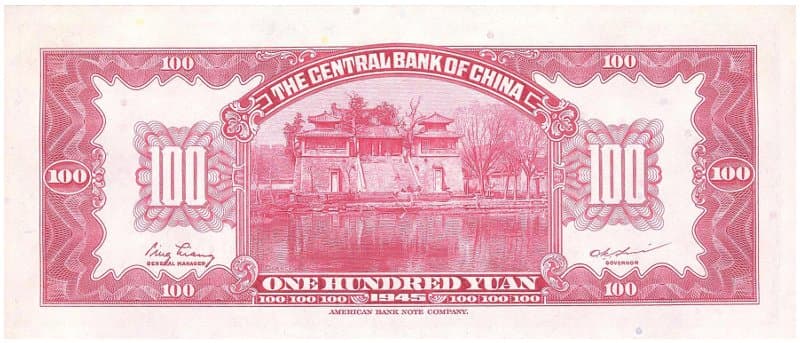
The vignette shows a pagoda and temple on a small island located in the middle of the Wulong River (乌龙江), which is a branch of the Min River (闽江), near the village of Hongtong (洪塘村) in the western suburb of the city of Fuzhou (福洲) in Fujian Province (福建).
The island is very small and rises only several meters above the river.
 At the left is
a photograph, taken by the Scottish
photographer John Thomson, of what the
temple looked like in the year 1879.
The photo shows the island from a
different angle and illustrates how the
temple with the pagoda in the back appears
to "float" serenely on the water.
At the left is
a photograph, taken by the Scottish
photographer John Thomson, of what the
temple looked like in the year 1879.
The photo shows the island from a
different angle and illustrates how the
temple with the pagoda in the back appears
to "float" serenely on the water.Because it is a temple with a pagoda located on an island, it resembles the famous Jin Shan (Gold Mountain) Temple in Jiangsu Province discussed above and the Chinese since ancient times have popularly referred to it as "Little Jin Shan" (小金山).
The temple was originally built in the year 1131 AD of the Song Dynasty.
The Jinshan Pagoda (金山塔) is eight-sided and has seven stories. It is made of granite and is about 7 meters in height.
The small temple complex includes the "Guanyin Pavilion" or "Goddess of Mercy Pavilion" (guanyinge 观音阁) and the "Building of Great Mercy" (dacilou 大慈楼).
The "Building of Great Mercy" has two rooms with interesting histories. The left room is known as Qiaqiazhai (恰恰斋) and is where General Zhang Jing (张经) of the Ming Dynasty studied when he was young. General Zhang Jing (1492-1555) achieved success in fighting the Japanese pirates that operated in the Chinese coastal waters from the 14th to 16th centuries. However, he later fell into disfavor and was arrested and ordered beheaded by Emperor Jiajing (嘉靖) in 1555.
The right room is known as Jiejieshi (借借室) which translates as the "Borrowed Room". Lin Longjiang (林龙江), also known as Lin Zhao'en (林兆恩), studied and wrote for a time in this room. Because his table, chair and other furniture were all borrowed from neighboring villagers, the room became known as the "Borrowed Room".
Lin Longjiang (1517-1598) was the founder of a popular religion known as the "Three In One Religion" (san yi jiao 三一教) which assimilated the teachings of Confucianism, Daoism (Taoism) and Buddhism into one religion. He is also recognized as having played a major role in providing food and medicine to the Chinese who suffered from the bloody attacks of the Japanese pirates during this time.
The Fuzhou Jinshan Temple as it exists today was reconstructed in 1934.
Beiji Temple

This
is a One Hundred Yuan ("One Hundred
Dollar" yi bai yuan 壹百圆)
banknote issued in 1945 by The Central
Bank of China (zhongyang
yinhang 中央银行) and printed by
the American Bank Note Company.
The vignette is the Beiji Temple (beiji ge 北极阁) which is located on the north shore of Daming Lake (大明湖), famous for its lotus and willow trees, in the city of Jinan (济南), Shandong Province (山东省).
Beiji Ge translates as "North Pole Temple" and this Daoist temple is dedicated to Zhenwu (真武大帝), the God of the North.
The Beiji Temple was originally built in 1280 during the Yuan Dynasty and then restored during the reign (1402-1424) of the Yongle Emperor (永乐) of the Ming Dynasty.
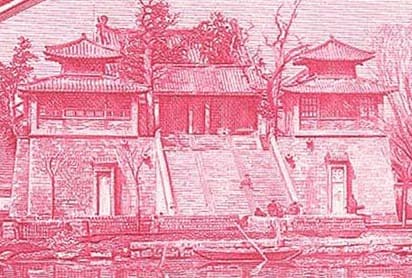 The
temple stands on a 7 meter (23 feet)
tall stone base and occupies an area
of 1,078 m2 (11,603 ft2).
The front of the temple faces Daming
Lake and part of Jinan's ancient city
wall runs along the back.
The
temple stands on a 7 meter (23 feet)
tall stone base and occupies an area
of 1,078 m2 (11,603 ft2).
The front of the temple faces Daming
Lake and part of Jinan's ancient city
wall runs along the back.
There is a Bell Tower (钟楼) on one side and a Drum Tower (鼓楼) on the other.
The main hall is dedicated to Zhenwu (真武大帝) and the rear hall is dedicated to the father and mother of Zhenwu.
According to Daoist belief, Zhenwu is the God of the North who also rules over water.
The original Zhenwu statue and murals, unfortunately, no longer exist and have since been replaced.
However, the base of the Zhenwu statue is the original and consists of a tortoise and snake representing Xuanwu (玄武).
The temple has been a favorite spot for young children since ancient times. Because of the tall base and steep stairs, children love to slide down the flat stone slabs on their bottoms. As a result, these stone slabs have been worn smooth.
The vignette is the Beiji Temple (beiji ge 北极阁) which is located on the north shore of Daming Lake (大明湖), famous for its lotus and willow trees, in the city of Jinan (济南), Shandong Province (山东省).
Beiji Ge translates as "North Pole Temple" and this Daoist temple is dedicated to Zhenwu (真武大帝), the God of the North.
The Beiji Temple was originally built in 1280 during the Yuan Dynasty and then restored during the reign (1402-1424) of the Yongle Emperor (永乐) of the Ming Dynasty.
 The
temple stands on a 7 meter (23 feet)
tall stone base and occupies an area
of 1,078 m2 (11,603 ft2).
The front of the temple faces Daming
Lake and part of Jinan's ancient city
wall runs along the back.
The
temple stands on a 7 meter (23 feet)
tall stone base and occupies an area
of 1,078 m2 (11,603 ft2).
The front of the temple faces Daming
Lake and part of Jinan's ancient city
wall runs along the back.There is a Bell Tower (钟楼) on one side and a Drum Tower (鼓楼) on the other.
The main hall is dedicated to Zhenwu (真武大帝) and the rear hall is dedicated to the father and mother of Zhenwu.
According to Daoist belief, Zhenwu is the God of the North who also rules over water.
The original Zhenwu statue and murals, unfortunately, no longer exist and have since been replaced.
However, the base of the Zhenwu statue is the original and consists of a tortoise and snake representing Xuanwu (玄武).
The temple has been a favorite spot for young children since ancient times. Because of the tall base and steep stairs, children love to slide down the flat stone slabs on their bottoms. As a result, these stone slabs have been worn smooth.
Xilituzhao

The "Mengchiang Bank" or "Inner-Mongolian Bank" was one of the banks established by the Japanese during their invasion and occupation of China.
The vignette shows "Xilituzhao" (席力图召), also known as the "Xilitu Temple", "Xilituzhao Lamasery" and "Shireet� zuu". It is located in Hohhot (呼和浩特), Inner Mongolia (neimengu 内蒙古).
Even though it is commonly referred to as "little temple" (xiao zhao 小召), it is actually the largest Lama temple in the old city.
"Xilitu" (席力图) means "Holy Seat (of Dalai Lama)" in Tibetan and "zhao" (召) is the Mongolian word for "temple".
In 1578 during the early years of the Wan Li reign of Emperor Shen Zong (1573-1620) of the Ming Dynasty, the Altan Khan (俺答汗) (1507-1582), who was the prince of the Mongolian T�med tribe, met with the Tibetan lama Sonam Gyatso (索南嘉错) and bestowed upon him the title "Dalai Lama" (达赖喇嘛). Sonam Gyatso was the first officially recognized Dalai Lama but became the "3rd Dalai Lama" after the title was later bestowed upon two predecessors.
Sonam Gyatso was a monk of the Tibetan Gelugpa (格鲁派) or "Yellow Hat" school of Buddhism and together with Altan Khan gradually converted the Mongols from their traditional shamanism to Tibetan Buddhism.
Altan Khan built a number of Buddhist temples in the capital city of Kh�kh Khot (Hohhot) including the Xilituzhao Temple.
Yonten Gyatso (1589-1617), the great-grandson of Altan Khan, became the 4th Dalai Lama. Born a Mongolian, Yonten Gyatso has been the only non-Tibetan to ever become a Dalai Lama.
Yonten Gyatso began his religious studies at Xilituzhao Temple, which was the home of his tutor Huofu Xitiuke, before leaving for Tibet in 1599 at the age of ten.
This Buddhist Lama Temple of Xilitu Zhao was built in the Tibetan style and was greatly expanded during the Qing Dynasty.
If you look carefully at the roof above the middle section of the temple, you will see on pedestals a Buddhist Wheel of Dharma with two deer, one on each side. The Wheel of Dharma symbolizes "knowledge". The Wheel of Dharma together with the two deer represents the Buddha's first turning of the Wheel of Dharma at Deer Park in Sarnath, India.
Behind the Wheel of Dharma, but which unfortunately cannot be seen in the vignette, are two victory banners as well as a jeweled trident.
The victory banners are symbols proclaiming that the Buddha's teachings conquer all.
The jeweled trident represents the Three Buddhas (past, present and future). The Three Jewels can be interpreted as "the Buddha, the doctrine, and the monastic community" or the "body, speech and mind".
The Wheel of Dharma and the victory banner are two of the Eight Treasures of Buddhism.
Since 1735, Xilituzhao Temple has been the official residence of the Living Buddha who is responsible for all Buddhist activities for the city.
This is a 100 Yuan (yi bai yuan 壹百元 "$100") banknote issued in the 27th year (1938) of the Republic by the Federal Reserve Bank of China (zhongguo lianhe zhunbei yinhang 中国联合准备银行), also known as the United Reserve Bank of China, and printed by the Executive Committee (xingzheng weiyuanhui 行政委员会).
The "Federal Reserve Bank of China" was one of the banks operated by the Japanese puppet government that occupied northeast China during the Second World War.
The vignette on the right side is the legendary "Yellow Emperor" (huangdi 黄帝) who is considered the founder of the Chinese civilization and one of the "Three Sovereigns and Five Emperors". He was believed to have reigned from 2696 BC - 2598 BC.
The Yellow Emperor is credited with teaching the people how to build homes, grow crops, and tame wild animals. He invented clothing, carts, boats, the south-pointing chariot and the Chinese musical instrument known as the guqin. He commanded one of his officials to invent the first Chinese writing system which is the script used on oracle bones. He also helped establish the Chinese calendar, early Chinese astronomy, and traditional Chinese medicine.
His wife, Lady Xiling (Lady Xi Ling Shi, leizu 祖祖), is recognized as discovering silk and the inventor of the silk loom.
This is a One Yuan (yi yuan 壹元 "$1") banknote issued by the Federal Reserve Bank of China (zhongguo lianhe zhunbei yinhang 中国联合准备银行), also known as the United Reserve Bank of China, and printed by the North China Printing Office (huabei zhengwu weiyuanhui yinshuaju 华北政务委员会印刷局).
There is no date on this banknote but the "Federal Reserve Bank of China" was a Japanese puppet government bank that printed paper money during the years 1938-1945.
The portrait on the right is Confucius and the vignette on the left is the Temple of Confucius (Confucius Temple kong miao孔庙) located at Confucius' hometown of Qufu in Shandong Province.
Confucius (Kong Fuzi 孔夫子), who lived from 551 BC to 479 BC, was one of China's most famous philosophers and educators. His teachings, which he believed were lessons transmitted from very ancient times, became the moral foundation for Chinese society and government for more than two thousand years.
The Confucian concepts of righteousness and filial piety, illustrated by old Chinese charms, are discussed in detail at Confucian Charms.
The Confucian Temple at Qufu is the largest and oldest temple dedicated to the great philosopher. Other Chinese banknotes with vignettes of the Apricot Platform and Cemetery of Confucius are displayed above.
This is a Five Jiao (wu jiao 五角 "50 cents") banknote issued by the Central Bank of Manchuria also known as the Central Bank of Manchukuo (manzhou zhongyang yinhang 满洲中央银行).
The Central Bank of Manchuria, along with the Federal Reserve Bank of China, were banks created under the Japanese puppet state of Manchukuo in northeastern China. The Japanese created the Central Bank of Manchuria by annexing the Manchurian Provincial Bank, the Yongheng Government Bank of Jilin Province, the Government Bank of Heilongjiang Province and the Frontier Bank.
There is no date of issue printed on the note although it is believed that these banknotes were issued beginning in 1937. Also, the printer is not indicated on the note.
The portrait depicts Emperor Qianlong (Emperor Gao Zong) who reigned during the years 1736-1795 of the Qing (Ch'ing) Dynasty.
Emperor Qianlong is credited with using his military to expand China's borders. He was also a great patron of arts.
Dragons with five claws, symbolizing the emperor, form the right and left borders of the note. Another dragon is depicted on the chest of the emperor.
Emperor Qianlong is also shown holding a ruyi sceptre on his right.
Vignettes of Daily Life

The banknote shown above has a denomination of One Yuan (壹 圆 "one dollar") and was issued in the 29th year (1940) of the Republic of China by The Farmers Bank of China (zhongguo nongmin yinhang 中国农民银行). The note was printed by the Zhongguo Daye Gongsi (中国大业公司).
The vignette shows a group of farmers, with crop fields in the background, busy grinding grain with a stone grinder.
This banknote has a
denomination of One Hundred Yuan (yi bai yuan 壹百元
"one hundred dollars") and was issued by the
Sinkiang Commercial and Industrial Bank (xinjiang shangye
yinhang 新疆商业银行) in the 28th year
(1939) of the Republic of China.
The vignette illustrates the traditional division of labor in ancient China where the men labored in the fields while the women were busy weaving on their looms.
These activities became a major genre in Chinese art, poetry and even good luck charms. For a more in-depth discussion, please see "Men Plow, Women Weave".
The vignette illustrates the traditional division of labor in ancient China where the men labored in the fields while the women were busy weaving on their looms.
These activities became a major genre in Chinese art, poetry and even good luck charms. For a more in-depth discussion, please see "Men Plow, Women Weave".
Return to Ancient Chinese Charms and Coins
